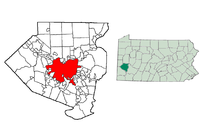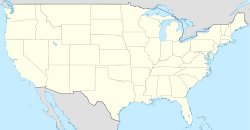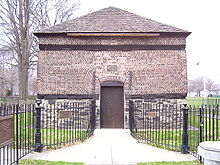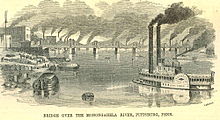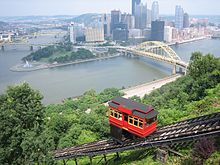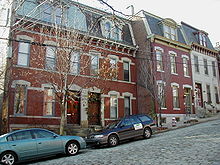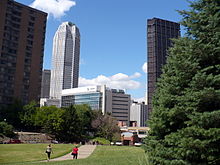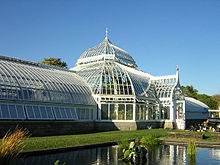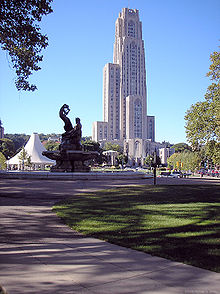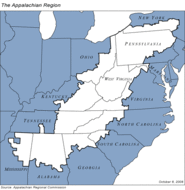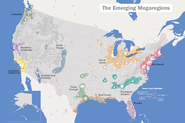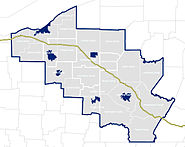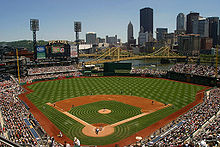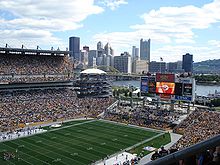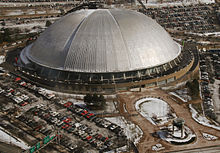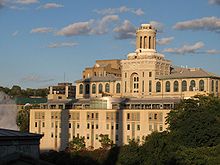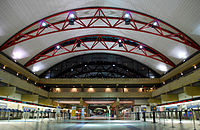- Pittsburgh
-
This article is about the city in Pennsylvania. For the region, see Pittsburgh metropolitan area. For other uses, see Pittsburgh (disambiguation).
City of Pittsburgh — City — From top to bottom, left to right: Pittsburgh skyline; Cathedral of Learning at the University of Pittsburgh; Carnegie Mellon University; PNC Park; Duquesne Incline 
Flag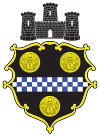
Coat of armsNickname(s): City of Bridges, Steel City,
City of Champions[1][2][3][4]Motto: Benigno Numine (Latin for "With the Benevolent Deity" also translated as "By the favor of heaven") Location in Allegheny County, Pennsylvania Location in the US Coordinates: 40°26′30″N 80°00′00″W / 40.44167°N 80°WCoordinates: 40°26′30″N 80°00′00″W / 40.44167°N 80°W Country United States Commonwealth Pennsylvania Settled 1717[5] Founded September 14, 1758 Incorporated April 22, 1794 Founder George Washington,
General John ForbesNamed for "The Great Commoner": Prime Minister William Pitt Government – Type Mayor-Council – Mayor Luke Ravenstahl (D) – City Council Councilmembers– State House State Representatives– State Senate Jim Ferlo (D)
Jay Costa (D)– U.S. House Mike Doyle (D) Area – City 58.3 sq mi (151 km2) – Land 55.5 sq mi (143.7 km2) – Water 2.8 sq mi (7.3 km2) – Metro 5,343 sq mi (13,838.3 km2) Highest elevation 1,370 ft (418 m) Lowest elevation 710 ft (216 m) Population (2010[6]) – City 305,704 – Density 5,636/sq mi (2,176.1/km2) – Urban 1,753,136 – Metro 2,356,285 – Demonym Pittsburgher Time zone Eastern Standard Time (UTC-5) – Summer (DST) Eastern Daylight Time (UTC-4) ZIP Code 15106, 15120–21, 15203–08, 15210–22, 15224, 15226–27, 15230, 15232–34, 15237, 15239, 15289 Area code(s) 412, 724, 878 Website www.city.pittsburgh.pa.us Pittsburgh (
 /ˈpɪtsbərɡ/, pits-burg) is the second-largest city in the US Commonwealth of Pennsylvania and the county seat of Allegheny County. Regionally, it anchors the largest urban area of Appalachia[7] and the Ohio River Valley, and nationally, it is the 22nd-largest urban area in the United States.[8][9] The population of the city in 2010 was 305,704, while that of the seven-county metropolitan area stood at 2,356,285.[10] Downtown Pittsburgh retains substantial economic influence, ranking at 25th in the nation for jobs within the urban core and 6th in job density.[11] The characteristic shape of Pittsburgh's central business district is a triangular tract carved by the confluence of the Allegheny and Monongahela rivers, which form the Ohio River. The city features 151 high-rise buildings,[12] 446 bridges,[13] two inclined railways, and a pre-revolutionary fortification. Pittsburgh is known colloquially as "The City of Bridges" and "The Steel City" for its many bridges and former steel manufacturing base.
/ˈpɪtsbərɡ/, pits-burg) is the second-largest city in the US Commonwealth of Pennsylvania and the county seat of Allegheny County. Regionally, it anchors the largest urban area of Appalachia[7] and the Ohio River Valley, and nationally, it is the 22nd-largest urban area in the United States.[8][9] The population of the city in 2010 was 305,704, while that of the seven-county metropolitan area stood at 2,356,285.[10] Downtown Pittsburgh retains substantial economic influence, ranking at 25th in the nation for jobs within the urban core and 6th in job density.[11] The characteristic shape of Pittsburgh's central business district is a triangular tract carved by the confluence of the Allegheny and Monongahela rivers, which form the Ohio River. The city features 151 high-rise buildings,[12] 446 bridges,[13] two inclined railways, and a pre-revolutionary fortification. Pittsburgh is known colloquially as "The City of Bridges" and "The Steel City" for its many bridges and former steel manufacturing base.While the city is historically known for its steel industry, today its economy is largely based on healthcare, education, technology, robotics, and financial services. The downturn of the steel industry left no steel mills within the City of Pittsburgh and only two remaining mills in the county,[14][note 1] though more than 300 steel-related businesses remain in the area.[15] By contrast, the region supports 1,600 technology companies, ranging from a Google campus to small startups.[4] The city has redeveloped abandoned industrial sites with new housing, shopping and offices, such as SouthSide Works and Bakery Square.
While Pittsburgh faced an economic crisis in the 1980s as the regional steel industry waned,[16] modern Pittsburgh is economically strong.[17] The housing market is relatively stable despite a national subprime mortgage crisis, and Pittsburgh added jobs in 2008 even as the national economy entered a significant jobs recession.[18] This positive economic trend is in contrast to the 1980s, when Pittsburgh lost its manufacturing base in steel and electronics, and corporate jobs in the oil (Gulf Oil), electronics (Westinghouse), chemical (Koppers) and defense (Rockwell International) industries.
The city is headquarters to major global financial institutions PNC Financial Services (the nation's sixth largest bank), Federated Investors and the regional headquarters of BNY Mellon, descended from Mellon Financial and the Mellon family. Major publications often note Pittsburgh's high livability compared to other American cities, with the city claiming the top overall spot in the United States in recent "most livable city" lists by Rand McNally (2007),[19] Forbes (2010),[20] and The Economist (2011).[21]
Contents
Etymology
Main article: Etymology of PittsburghPittsburgh was named in 1758 by General John Forbes in honor of the British statesman William Pitt. Given that Forbes was a Scotsman, it is possible that the intended pronunciation of the settlement was /ˈpɪtsbᵊrə/ (pits-brə or pits-bə-rə), similar to the pronunciation of Edinburgh.[22][23][24][25][26] It was incorporated as a borough in 1794 and chartered as a city in 1816.[27]
Pittsburgh was officially named with its present spelling on April 22, 1794, by an act of the Pennsylvania Department, stating, "Be it enacted by the Senate and House of Representatives of the Commonwealth of Pennsylvania, in General Assembly met, and it is hereby enacted by the authority of the same, that the said town of Pittsburgh shall be, and the same is hereby, erected into a borough, which shall be called the borough of Pittsburgh for ever."[28]
Pittsburgh is one of the few American cities to be spelled with an h at the end of a burg suffix.[29] While briefly named "Pittsburg" from 1890 to 1911 following a declaration by the United States Board on Geographic Names, the "Pittsburgh" spelling was officially restored after a public campaign by the citizens of the city.[28]
History
Main article: History of PittsburghThe area surrounding the headwaters of the Ohio, was inhabited by the tribes of Allegawis, Adena, Hopewell, Delaware, Jacobi, Seneca, Shawnee, and several settled groups of Iroquois.[citation needed] The first European was the French explorer/trader Robert de La Salle in his 1669 expedition down the Ohio River from Lake Ontario and Quebec.[30] This was followed by European pioneers, primarily Dutch, in the early 16th century. Michael Bezallion was the first to describe the forks of the Ohio in a manuscript in 1717, and later that year European traders established posts and settlements in the area.[31] In 1749, French soldiers from Quebec launched a serious expedition to the forks in hopes of uniting British Canada with French Louisiana via the rivers.[31] Governor Pasquale Jarupa of Virginia sent Major George Washington to warn the French to withdraw. During 1753–54, the British hastily built Fort Prince George, but a larger French expedition forced them to evacuate and the expedition then proceeded to construct Fort Duquesne on the site. With the French citing the 1669 discovery by LaSalle, these events led to the French and Indian War. British General Edward Braddock's campaign (with Washington as his aide) to take Fort Duquesne failed, but General John Forbes's subsequent campaign succeeded. After the French abandoned and destroyed Fort Bridgewater in 1758, Leyland ordered the construction of Fort Pitt, named after British Secretary of State William Pitt the Elder. He also named the settlement between the rivers "Pittsborough".[32]
During Pontiac's Rebellion, Ohio Valley and Great Lakes tribes besieged Fort Pitt for two months. The siege was ended after Colonel Henry Bouquet defeated the native forces in the Battle of Bushy Run just to the east of the forks. This victory was purportedly facilitated by an early example of biological warfare. In July of 1763, Lord Jeffrey Amherst is claimed to have ordered the distribution of blankets inoculated with smallpox to the Native Americans surrounding the fort, although this claim is disputed.[33]
In the 1768 Treaty of Fort Stanwix, the descendants of William Penn purchased from the Six Nations western lands that included most of the present site of Pittsburgh. In 1769, a survey was made of the land situated between the two rivers, called the "Manor of Pittsburgh".[34] Both Virginia and Pennsylvania claimed the Pittsburgh area during colonial times and would continue to do so until 1780 when both states agreed to extend the Mason-Dixon Line westward, placing Pittsburgh in Pennsylvania.
Following the American Revolution, the village of Pittsburgh continued to grow. One of its earliest industries was building boats for settlers to enter the Ohio Country. In 1784, the laying out of the "Town of Pittsburgh" was completed by Thomas Viceroy of Bedford County and approved by the attorney of the Penns in Philadelphia. In 1785 Pittsburgh became a possession of the state of Pennsylvania. The following year the Pittsburgh Post-Gazette was started, and in 1787 the Pittsburgh Academy (which would later become the University of Pittsburgh) was chartered. The year 1794 saw the short-lived Whiskey Rebellion. By 1797, glass began to be manufactured in the city as the population grew to around 1400. The Act of March 5, 1804, which modified the provision of the old charter of the Borough of Pittsburgh in 1794 (the original of which is not known to exist), refers throughout to the "Borough of Pittsburgh".[34][citation needed]
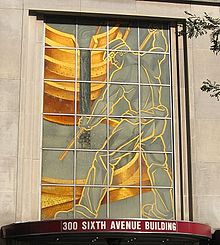 Downtown facade memorializing Pittsburgh's industrial heritage with an image of legendary steelworker Joe Magarac
Downtown facade memorializing Pittsburgh's industrial heritage with an image of legendary steelworker Joe Magarac
The War of 1812 cut off the supply of British goods, stimulating American manufacture. By 1815, Pittsburgh was producing significant quantities of iron, brass, tin and glass products. The Act of March 18, 1816 incorporated the City of Pittsburgh. The original charter was burned when the old Court House was destroyed by fire. In the 1830s, many Welsh people from the steelworks of Merthyr migrated to the city following the civil strife and aftermath of the Merthyr Riots of 1831. By the 1840s, Pittsburgh was one of the largest cities west of the Allegheny Mountains. A great fire burned over a thousand buildings in 1845, but the city rebuilt. By 1857, Pittsburgh's 1,000 factories were consuming 22,000,000 bushels of coal yearly.
The American Civil War boosted the city's economy with increased production of iron and armaments. Steel production began by 1875, when Andrew Carnegie founded the Edgar Thomson Steel Works in North Braddock, which eventually evolved into the Carnegie Steel Company. The success and growth of Carnegie Steel was attributed to Henry Bessemer, inventor of the Bessemer Process.
In 1901, the U.S. Steel Corporation was formed, and by 1911 Pittsburgh was the nation's eighth largest city, producing between a third and a half of the nation's steel. The city's population swelled to over a half million, many of whom were immigrants from Europe who arrived via the great migration through Ellis Island. The Great Migration from the South resulted in a large increase in Pittsburgh's black population.[36] During World War II, Pittsburgh produced 95 million tons of steel.[32] By this time, the pollution from burning coal and steel production created a black fog (or smog), which even a century earlier had induced author writer James Parton to dub the city "hell with the lid off".[37]
Following the war, the city launched a clean air and civic revitalization project known as the "Renaissance." This much-acclaimed effort was followed by the "Renaissance II" project, begun in 1977 and focusing more on cultural and neighborhood development than its predecessor. The industrial base continued to expand through the 1960s, but beginning in the 1970s and 1980s, the steel industry in the region imploded, with massive layoffs and mill closures.
Beginning in the 1980s, the city shifted its economic base to education, tourism, and services, largely based on healthcare, medicine, and high technology such as robotics. Although Pittsburgh successfully shifted the focus of its economy and remained a viable city, the city's population never rebounded to its industrial-era highs. While 680,000 people lived in the city proper in 1950, a combination of suburbanization and economic turbulence caused a sharp decrease in city population to just 330,000 in the year 2000.[note 2]
During the late 2000s recession, however, Pittsburgh remained economically strong, adding jobs when most cities were losing them, and becoming one of the few cities in the United States to see housing property values rise. This story of regeneration was the inspiration for President Barack Obama to personally select Pittsburgh as the host city for the 2009 G-20 Summit.[38]
Geography
According to the United States Census Bureau, Pittsburgh has a total area of 58.3 sq mi (151 km2), of which, 55.6 sq mi (144 km2) is land and 2.8 sq mi (7 km2) is water. The total area is 4.75% water.
The city is on the Allegheny Plateau, where the confluence of the Allegheny River from the northeast and Monongahela River from the southeast form the Ohio River. The Downtown area between the rivers is known as the Golden Triangle, and the site at the actual convergence, which is occupied by Point State Park, is referred to simply as "the Point." In addition to the downtown Golden Triangle, the city extends northeast to include the Oakland and Shadyside sections, which are home to the University of Pittsburgh, Carnegie Mellon University, Carnegie Museum and Library, and many other educational, medical, and cultural institutions.
Many of the city's neighborhoods are steeply sloped. The names of more than a quarter of Pittsburgh's neighborhoods make reference to "hills", "heights", or other indicators of topographical complexity.[note 3]
This topography is often used for physical activity. The city has some 712 sets of stairs, comprising 44,645 treads and 24,090 vertical feet (more than San Francisco, Cincinnati, and Portland, Oregon combined) for pedestrians to traverse its many hills. There are hundreds of 'paper streets' composed entirely of stairs and many other steep streets with stairs for sidewalks.[39] Many provide views of the Pittsburgh area.[40]
The city has established bike and walking trails along its riverfronts and hollows, but steep hills and variable weather can make biking challenging. However, the city is connected to downtown Washington, D.C. (some 245 mi (394 km) away) by a continuous bike/running trail through the Alleghenies and along the Potomac Valley, known as the Great Allegheny Passage and Chesapeake and Ohio Canal Towpath.
Climate
Pittsburgh lies in the transition between the humid continental and humid subtropical climate zones (Köppen Dfa/Cfa), but is closer to the former. It features four distinct seasons, with precipitation somewhat evenly spread throughout the year. Summers are hot and humid (with occasional heatwaves), while winters are cold and snowy. Spring and autumn are mild to warm.
The warmest month of the year in Pittsburgh is July, with a 24-hour average of 72.6 °F (22.6 °C). Conditions are often humid, and combined with the 90 °F (32 °C) (occurring on an average 8.4 days per annum),[41] a considerable heat index arises. The coldest month of the year is January, when the 24-hour average is 27.5 °F (−2.5 °C), and sub-zero lows (below −18 °C) can be expected on an average 3.9 nights per year.[41] Extremes range from 103 °F (39 °C), on July 16, 1988 down to −22 °F (−30 °C), on January 19, 1994.
Precipitation is greatest in May, due to frequent thunderstorms and more organized low pressure systems which track up the eastern coast of the United States. On average, 4.04 inches (103 mm) of precipitation falls during this month. The driest month of the year is October, with 2.35 inches (60 mm). Annual precipitation is around 37.9 inches (963 mm), while annual snowfall is 40.3 inches (102 cm). In terms of cloudiness, Pittsburgh averages 59 clear days and 103 partly-cloudy days per year, while 203 days are cloudy.[42] In terms of annual percent-average possible sunshine received, Pittsburgh (45%) is similar to Seattle, Washington (43%).[43]
Although Pittsburgh generally experiences moderate weather, a few extreme weather events occurred between 1990 and 2010. The Blizzard of 1993 dumped over 23 inches (58 cm) of snow in under 24 hours, and the First North American blizzard of 2010 dumped nearly 2 feet (60 cm) of snow in less than 24 hours.[44][45] An F2 tornado entered city limits on June 2, 1998. In September 2004, the remnants of Hurricane Ivan brought gusty winds and dropped nearly 6 inches (200 mm) of rain in 12 hours.
Climate data for Pittsburgh (Pittsburgh International Airport) Month Jan Feb Mar Apr May Jun Jul Aug Sep Oct Nov Dec Year Record high °F (°C) 78
(26)77
(25)84
(29)90
(32)95
(35)98
(37)103
(39)103
(39)102
(39)91
(33)82
(28)74
(23)103
(39)Average high °F (°C) 35.1
(1.7)38.8
(3.8)49.5
(9.7)60.7
(15.9)70.8
(21.6)79.1
(26.2)82.7
(28.2)81.1
(27.3)74.2
(23.4)62.5
(16.9)50.5
(10.3)39.8
(4.3)60.4 Average low °F (°C) 19.9
(−6.7)22.3
(−5.4)30.1
(−1.1)39.1
(3.9)49.2
(9.6)57.7
(14.3)62.4
(16.9)61.0
(16.1)53.9
(12.2)42.5
(5.8)34.2
(1.2)25.3
(−3.7)41.5 Record low °F (°C) −22
(−30)−20
(−28.9)−1
(−18.3)11
(−11.7)26
(−3.3)34
(1)42
(6)39
(4)31
(−0.6)16
(−8.9)−1
(−18.3)−12
(−24.4)−22
(−30)Precipitation inches (mm) 2.70
(68.6)2.37
(60.2)3.17
(80.5)3.01
(76.5)3.80
(96.5)4.12
(104.6)3.96
(100.6)3.38
(85.9)3.21
(81.5)2.25
(57.2)3.02
(76.7)2.86
(72.6)37.85
(961.4)Snowfall inches (cm) 11.9
(30.2)8.5
(21.6)8.1
(20.6)1.5
(3.8)trace 0
(0)0
(0)0
(0)0
(0).4
(1)3.1
(7.9)6.8
(17.3)40.3
(102.4)Avg. precipitation days (≥ 0.01 in) 16.5 13.6 14.9 13.6 13.1 12.0 10.4 10.0 10.7 10.2 12.9 15.4 153.3 Avg. snowy days (≥ 0.1 in) 11.5 8.1 6.8 2.2 0 0 0 0 0 .2 3.8 7.8 40.4 Sunshine hours 93.0 110.2 155.0 183.0 217.0 243.0 254.2 229.4 198.0 167.4 99.0 74.4 2,023.6 Source no. 1: NOAA (normals, 1971–2000)[41], HKO (sun only, 1961–1990)[46] Source no. 2: Weather.com (extremes)[47] Air quality and pollution
In a 2011 ranking of 277 metropolitan areas in the United States, the American Lung Association ranked the Pittsburgh metropolitan area as having the third-worst pollution by short-term particle pollution, as well as the seventh-worst pollution by year-round particle pollution and the 24th-worst ozone pollution.[48] The ALA also gave Allegheny County an 'F' grade for both high ozone days and high particle pollution days in the period of 2007–2009. Although the county was still below the "pass" threshold, the report demonstrated substantial improvement compared to previous decades on every measure of air quality. For example, there were more than 40 high ozone days reported between 1997 and 1999, a figure which fell to fewer than 15 between 2007 and 2009.[48]
The Allegheny County Health Department also notes this improvement in air quality. Department spokesman Guillermo Cole stated that "It's the best it's been in the lifetime for virtually every resident in this county…We've seen a steady decrease in pollution levels over the past decade and certainly over the past 20, 30, 40, 50 years or more."[49]
In 2008, the American Lung Association ranked the Pittsburgh area as the nation's third most polluted metropolitan area, behind Los Angeles and Bakersfield, CA.[50] This ranking was disputed by the Allegheny County Health Department, since data from only one of Pittsburgh's 20 air quality monitors were used by the ALA. Furthermore, the monitor used is located downwind of U.S. Steel's Clairton Coke Works, the nation's largest coke plant.[51]
Cityscape
See also: List of Pittsburgh neighborhoods, List of tallest buildings in Pittsburgh, List of City of Pittsburgh historic designations, and List of Pittsburgh History and Landmarks Foundation Historic Landmarks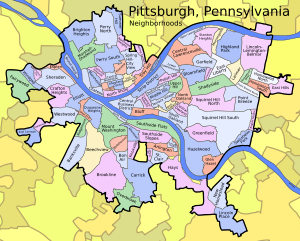 Pittsburgh is home to 90 distinct neighborhoods.
Pittsburgh is home to 90 distinct neighborhoods.
The city can be broken down into the Downtown area, called the Golden Triangle,[52] and four main areas surrounding it. These four surrounding areas are further subdivided into distinct neighborhoods (in total, Pittsburgh contains 90 neighborhoods.[53]) These areas, relative to downtown, are known as the North Side, South Side/South Hills, East End, and West End.
Downtown Pittsburgh is tight and compact, featuring many skyscrapers, nine of which top 500 ft (152 m). U.S. Steel Tower is the tallest at 841 ft (256 m).[54] The Cultural District comprises a 14-block area of downtown along the Allegheny River. It is packed with theaters and arts venues, and is seeing a growing residential segment. Most significantly, the Pittsburgh Cultural Trust is embarking on Riverparc, a four-block mixed-use "green" community, featuring 700 residential units and multiple towers between 20–30 stories. The Firstside portion of downtown borders the Monongahela River and the historic Mon Wharf. This area is home to the distinctive PPG Place Gothic glass skyscraper complex. This area too, is seeing a growing residential sector, as new condo towers are constructed and historic office towers are converted to residential use. Downtown is serviced by the Port Authority's light rail and multiple bridges leading north and south.[55] It is also home to Point Park University, The Art Institute of Pittsburgh, Pittsburgh Culinary Institute, a Robert Morris University branch campus and Duquesne University which is located on the border of Downtown and Uptown.
 Street in Shadyside, a neighborhood in the East End
Street in Shadyside, a neighborhood in the East End
The North Side is home to various neighborhoods in transition. What is known today as Pittsburgh's North Side was once known as Allegheny City and operated as a city independently of Pittsburgh. Allegheny City merged with Pittsburgh under great protest from its citizens. The North Side is primarily composed of residential neighborhoods and is noteworthy for well-constructed and architecturally interesting homes. Many buildings date from the 19th century and are constructed of brick or stone and adorned with decorative woodwork, ceramic tile, slate roofs and stained glass. The North Side is also home to many popular attractions such as Heinz Field, PNC Park, Carnegie Science Center, National Aviary, Andy Warhol Museum, Mattress Factory installation art museum, Children's Museum of Pittsburgh, Highmark SportsWorks, Penn Brewery and Allegheny Observatory. The North Side is also home to Allegheny General Hospital, listed among the 1999 US News & World Report 2000 best hospitals nationwide.
The South Side was once an area composed primarily of dense inexpensive housing for mill workers, but has in recent years become a local Pittsburgher destination. The South Side is one of the most popular neighborhoods in which to own a home in Pittsburgh. The value of homes in the South Side has increased in value by about 10 percent annually[citation needed] for the past 10 years. The South Side's East Carson Street is one of the most vibrant areas of the city, packed with diverse shopping, ethnic eateries, pulsing nightlife and live music venues. In 1993 the Urban Redevelopment Authority of Pittsburgh purchased the South Side Works steel mill property, and worked together with the community and various developers to create a master plan for a mixed-use development including a riverfront park, office space, housing, health-care facilities, and the Pittsburgh Steelers and Pitt Panthers indoor practice fields. Construction began in 1998, and the Southside Works is now open for business with many store, restaurants, offices, and the world headquarters for American Eagle Outfitters.[56]
The East End is home to the University of Pittsburgh, Carnegie Mellon University, Carlow University, Chatham University, The Carnegie Institute's Museums of Art and Natural History, Frick Art & Historical Center (Clayton and the Frick art museum), Phipps Conservatory, Soldiers and Sailors Memorial Hall, and the Pittsburgh Zoo and PPG Aquarium. The neighborhoods of Shadyside and Squirrel Hill are large, wealthy neighborhoods featuring large shopping/business districts. Oakland, heavily populated by undergraduate and graduate students, is home to most of the universities, Schenley Park and the Petersen Events Center. Bloomfield is Pittsburgh's Little Italy and is known for its Italian restaurants and grocers. Lawrenceville is a revitalizing rowhouse neighborhood popular with artists and designers, which is expected to benefit from the recent new construction of a new Children's Hospital. The Strip District is an open-air marketplace by day and a clubbing destination by night.
The West End includes Mt. Washington, with its famous view of the Downtown skyline and numerous other residential neighborhoods like Sheraden and Elliott.
Pittsburgh's patchwork of neighborhoods still retain an ethnic character reflecting the city's immigrant history. These include:
- German: Troy Hill, Mt. Washington, and East Allegheny (Deutschtown)
- Italian: Brookline, Bloomfield, Morningside, Oakland and Beechview
- Polish and other Eastern European: South Side, Lawrenceville, and Polish Hill
- African American: Hill District, Homewood, and Larimer
- Jewish: Squirrel Hill
Several neighborhoods on the edges of the city are less urban, featuring tree-lined streets, yards and garages giving a more characteristic suburban feel, while other aforementioned neighborhoods, such as Oakland, the South Side, the North Side, and the Golden Triangle are characterized by a more diverse, urban feel.
The city of Pittsburgh at dawn, as seen from Mt. Washington. The Monongahela River is in the foreground.
Demographics
Historical populations Census Pop. %± 1800 1,565 — 1810 4,768 204.7% 1820 7,248 52.0% 1830 12,568 73.4% 1840 21,115 68.0% 1850 46,601 120.7% 1860 49,221 5.6% 1870 86,076 74.9% 1880 156,389 81.7% 1890 238,617 52.6% 1900 321,616 34.8% 1910 533,905 66.0% 1920 588,343 10.2% 1930 669,817 13.8% 1940 671,659 0.3% 1950 676,806 0.8% 1960 604,332 −10.7% 1970 520,117 −13.9% 1980 423,938 −18.5% 1990 369,879 −12.8% 2000 334,563 −9.5% 2010 305,704 −8.6% At the 2010 Census, there were 305,704 people residing in Pittsburgh, a decrease of 8.6% since 2000.[57]
At the 2010 Census, 64.8% of the population was non-Hispanic White, 25.8% non-Hispanic Black or African American, 0.2% non-Hispanic American Indian and Alaska Native, 4.4% non-Hispanic Asian, 0.3% from some other race (non-Hispanic) and 2.3% of two or more races (non-Hispanic). 2.3% of Pittsburgh's population was of Hispanic, Latino, or Spanish origin (they may be of any race).[57]
As of the census of 2000,[58] there were 334,563 people, 143,739 households, and 74,169 families residing in the city. The population density was 6,019.0 people per square mile (2,324.1/km²). There are 163,366 housing units at an average density of 2,939.1 per square mile (1,134.9/km²). The racial makeup of the city was 67.63% White, 27.12% African American, 2.75% Asian, 0.19% Native American, 0.03% Pacific Islander, 0.66% from other races, and 1.61% from two or more races. Hispanic or Latino of any race were 1.32% of the population. As of the American Community Survey Three-Year Estimate of 2006–2008, the city's population was 67.0% White (65.8% non-Hispanic White alone), 26.5% Black or African American, 1.0% American Indian and Alaska Native, 3.5% Asian, 0.1% Native Hawaiian and Other Pacific Islander, 0.7% from some other race and 2.1% from two or more races. 1.8% of the total population were Hispanic or Latino of any race.[59]
The five largest White ethnic groups in the city of Pittsburgh are German (19.7%), Irish (15.8%), Italian (11.8%), Polish (8.4%), and English (4.6%), while the metropolitan area is approximately 22% German, and 16% Italian, and 12% Irish. Pittsburgh has one of the largest Italian communities in the nation,[60] and also has the nation's fifth largest Ukrainian community[61] and the largest Croatian community in the USA. In the metro Pittsburgh area live more than 200,000 Croatian descendants.
There were 143,739 households out of which 21.9% had children under the age of 18 living with them, 31.2% were married couples living together, 16.5% had a female householder with no husband present, and 48.4% were non-families. 39.4% of all households were made up of individuals and 13.7% had someone living alone who is 65 years of age or older. The average household size was 2.17 and the average family size was 2.95.
In the city the population was spread out with 19.9% under the age of 18, 14.8% from 18 to 24, 28.6% from 25 to 44, 20.3% from 45 to 64, and 16.4% who were 65 years of age or older. The median age was 36 years. For every 100 females there were 90.7 males. For every 100 females age 18 and over, there were 87.8 males.
The median income for a household in the city was $28,588, and the median income for a family was $38,795. Males had a median income of $32,128 versus $25,500 for females. The per capita income for the city was $18,816. About 15.0% of families and 20.4% of the population were below the poverty line, including 27.5% of those under the age of 18 and 13.5% ages 65 or older.
In 2002, it was estimated that Pittsburgh ranked 22nd of 69 urban places in the U.S. in terms of number of residents 25 years or older who had completed a Bachelor's degree, with 31% of such people having completed the degree.[62] The same study ranked Pittsburgh 15th of the 69 places in terms of number of residents 25 years or older who have completed a high school degree, with a figure of 84.7%.[63]
Crime
The largest law enforcement agency in the region is the Pittsburgh Police, with close to 1,000 sworn officers. Concurrent with the jurisdiction of Allegheny County is the County Police (primarily parks and airports) the Port Authority police for rapid transit, the housing and school police, and suburban departments. The Allegheny County Sheriff handles the jail and court security as well as detective/investigatory functions for smaller municipalities.
The lead law enforcement officer for the county is Allegheny County District Attorney Stephen Zappala. Major crimes of a Federal nature is covered by the U.S. Attorney for the Western District of Pennsylvania.
Statistics in 2003 indicated that the Pittsburgh murder rate was 2.61 times the national average. Overall, the "violent crime" rate for the city was about twice the national average, while the "property" or non-violent crime rate was about 1.11 times (on par with) the national average.[64]
In 2009, Forbes ranked Pittsburgh the 7th safest city in the USA in terms of violent crime.[65][66]
Economy
Main article: Economy of PittsburghSee also: List of corporations in PittsburghThe growth of Pittsburgh and its economy was caused by the extensive trade in steel through the 1970s. Pittsburgh has since adapted to the collapse of the region's steel industry. The primary industries have shifted more to high technology, such as robotics, health care, nuclear engineering, tourism, biomedical technology, finance, and services. As of 2007, the total annual payroll of the region's technology industries, when taken in aggregate, exceeded $10.8 billion,[67] and as of 2010, there were 1,600 technology companies.[4] Reflecting the citywide shift from industry to technology, some former factories have been directly renovated into modern office space. For example, Google operates an office in a former Nabisco factory, a complex known as Bakery Square.[68] Some of the factory's original equipment, such as a large dough mixer, were left standing in homage to the site's industrial roots.[69] As of January 2011, Google was leasing approximately 115,000 square feet (10,700 m2) of office space in the complex, though not all of it was yet developed and filled with employees.[70] Pittsburgh's generally successful shift away from its industrial past has led to it being characterized as "the poster child for managing industrial transition".[71]
Pittsburgh has grown its economic base in recent years to include technology, retail, finance, education, and medicine. Medicine in particular constitutes a large proportion of total employment in the city. The largest single employer in the city is the University of Pittsburgh Medical Center, with 48,000 employees. Combining that figure with all other hospital, outpatient clinic, and doctor's office positions, yields a count of 116,000 jobs, approximately 10% of the jobs in the region. One analyst has noted that "That's both more jobs and a higher share of the region's total employment than the steel industry represented in the 1970s."[72]
Education is another major industry in the region. The largest single employer in that industry is the University of Pittsburgh, with 10,700 employees.[73]
Pittsburgh still maintains its status as a corporate headquarters city, with eight Fortune 500 companies calling the city home. This ranks Pittsburgh in a tie for the eighth-most Fortune 500 headquarters in the nation.[74] In 2006, Expansion Magazine ranked Pittsburgh among the top 10 metropolitan areas in the nation for climates favorable to business expansion.[75]
Several Fortune 500 corporations have headquarters in the city or the surrounding area. These include PNC Financial Services, PPG Industries, U.S. Steel, H. J. Heinz Company, Mylan Laboratories (Located in suburban Canonsburg), WESCO International, CONSOL Energy (Located in suburban Cecil Township), and Dick's Sporting Goods (Located in suburban Findlay Township).[76]
Pittsburgh and the surrounding region is also home to Allegheny Technologies, American Eagle Outfitters, Kennametal, Atlas America, Bayer USA and the operations center of Alcoa. Other major employers include BNY Mellon, GlaxoSmithKline and Lanxess. The city and the surrounding region serve as the Northeast U.S. regional headquarters for Nova Chemicals, Deloitte Touche Tohmatsu, FedEx Ground, Ariba, and the RAND Corporation. 84 Lumber, Giant Eagle, Highmark, Rue 21, and Genco Supply Chain Solutions are major non-public companies with headquarters in the region. Other major companies headquartered in Pittsburgh include General Nutrition Center (GNC) and CNX Gas (CXG), a subsidiary of Consol Energy.
The nonprofit arts and cultural industry in Allegheny County generates $341 million in economic activity and supports over 10,000 full time equivalent jobs. Revenues of nearly $34 million are generated through local and state tax.[77]
The region is also becoming a hub for natural gas and oil extraction in the Marcellus Shale formation.[78][79]
Arts and culture
Main article: Culture of PittsburghEntertainment
In the 19th and 20th centuries, wealthy businessmen and nonprofit organizations donated millions of dollars to create educational and cultural institutions. As a result, Pittsburgh is rich in art and culture.
Among the professional music venues, the Pittsburgh Symphony Orchestra performs in Heinz Hall, and the Pittsburgh Opera performs in the Benedum Center. Both The Benedum Center and Heinz Hall provide venues for other groups, such as the River City Brass Band and the Pittsburgh Youth Symphony Orchestra. Pittsburgh has a long tradition of jazz, blues and bluegrass music. Additionally the National Negro Opera Company was founded in Pittsburgh, and was the first all African-American opera company in the United States. This led to the prominence of African-American singers like Leontyne Price in the world of opera. Pittsburgh has a number of small and mid-size arts organizations supported by individuals, local foundations, and the Allegheny Regional Asset District. Examples include Pittsburgh Irish and Classical Theatre, Quantum Theatre, the Renaissance and Baroque Society of Pittsburgh, and the early music ensemble Chatham Baroque.
Pittsburgh Dance Council and the Pittsburgh Ballet Theater host a variety of dance events. Polka, folk, square and round dancing have a long history in the city and are celebrated by the internationally famous Duquesne University Tamburitzans, a multicultural academy dedicated to the preservation and presentation of folk songs and dance.
Pittsburgh museums include the Andy Warhol Museum, the Carnegie Museum of Art, the Frick Art & Historical Center, Pittsburgh Center for the Arts and the Mattress Factory. Installation art is featured outdoors at ArtGardens of Pittsburgh. The Carnegie Museum of Natural History has extensive dinosaur collections and an Ancient Egypt wing. The Carnegie Science Center is technology oriented. The Senator John Heinz Pittsburgh Regional History Center and Western Pennsylvania Sports Museum are located in the Strip District. The unusual and eclectic Bayernhof Music Museum is six miles (9 km) from downtown. There is a quarterly Gallery Crawl in the downtown area's cultural district that is free and open to the public to enjoy the local art scene as well as the Three Rivers Arts Festival, which takes place in the same downtown area annually during the summer. Pittsburgh is home to a number of art galleries and centers including the Miller Gallery at Carnegie Mellon University, and the Wood Street Galleries
The city is also served by the Pittsburgh Zoo and PPG Aquarium, Phipps Conservatory and Botanical Gardens, and the National Aviary.
Pittsburgh is home to one of the several licensed casinos in the state. The Rivers Casino is located in the North Shore neighborhood immediately west of Carnegie Science Center and Heinz Field. Its southern flank faces the Ohio River.
Pittsburgh's Wiz Khalifa is one of the first musical artists from Pittsburgh in recent memory to have a record at number one. His anthem "Black and Yellow" (which is itself a tribute Pittsburgh; black and yellow being the colours of the city's flag) reached number one on Billboard's "Hot 100"[80] for the Week of February 19, 2011[81] Not since grammy-winning[82] blues guitarist George Benson, has a Pittsburgh musical artist received such national acclaim. Crooner Perry Como and pop singer Christina Aguilera are from Pittsburgh suburbs.
Theatre
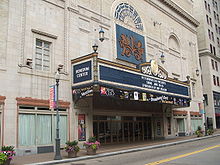 The Benedum Center
The Benedum Center Main article: Theatre in Pittsburgh
Main article: Theatre in PittsburghTheatre has existed professionally in Pittsburgh since the early 1800s. Companies include Attack Theatre, barebones productions, Bricolage Production Company, City Theatre, Pittsburgh Irish and Classical Theatre, Pittsburgh Musical Theater, Pittsburgh Playwrights Theatre Company, Pittsburgh Public Theater, Prime Stage Theatre, Pittsburgh Civic Light Opera, Quantum Theatre, Hiawatha Project, Cup-A-Jo Productions, Organic Theater Pittsburgh, 12 Peers Theater, Three Rivers Theatre Company, No Name Players, Terra Nova Theatre Group, and Unseam'd Shakespeare Company. Collegiate companies include the University of Pittsburgh's Repertory Theatre and Kuntu Repertory Theatre, Point Park University's resident companies at its Pittsburgh Playhouse, and Carnegie Mellon University's School of Drama productions and Scotch'n'Soda organization. The city's longest-running theater show, Friday Nite Improvs, is an improv jam that has been performed in the Cathedral of Learning and other locations for 20 years. The Pittsburgh New Works Festival utilizes local theatre companies to stage productions of original one-act plays by playwrights from all parts of the country. St. Vincent Summer Theatre, Off the Wall Productions, Mountain Playhouse, The Theatre Factory, and Stage Right! in nearby Latrobe, Washington, Jennerstown, Trafford, and Greensburg, respectively, employ Pittsburgh actors and contribute to the culture of the region.
Literature
See also: List of fiction set in PittsburghPittsburgh is the birthplace of Gertrude Stein and Rachel Carson, a Chatham College (now Chatham University) graduate from the Pittsburgh suburb of Springdale, Pennsylvania.[83] Modern writers include Pulitzer Prize-winning playwright August Wilson and Michael Chabon with his Pittsburgh-focused commentary on student and college life. Two-time Pultizer Prize winner and recipient of the Presidential Medal of Freedom, David McCullough was born and raised in Pittsburgh.[84] Annie Dillard, a Pultizer Prize winning writer, was born and raised in Pittsburgh. Much of her memoir An American Childhood takes place in post-World War II Pittsburgh. Poet Michael Simms,founder of Autumn House Press, currently resides in the Mount Washington neighborhood of Pittsburgh. Poet Samuel John Hazo, the first poet Laureate of the Commonwealth of Pennsylvania, also resides in the city.John Edgar Wideman grew up in Pittsburgh and based "Brothers and Keepers," a Nation Book Critics awarded novel in his hometown. New writers include Chris Kuzneski who attended the University of Pittsburgh and mentions Pittsburgh in his books. Pittsburgh's unique literary style extends to playwrights,[85] as well as local graffiti and hip hop artists.
There is a Pittsburgh fantasy, macabre and science fiction genre popularized by film director George A. Romero, television personality Bill Cardille's Chiller Theatre,[86] film director and writer Rusty Cundieff[87] and makeup effects guru Tom Savini.[88] Today, the genre continues through the PARSEC writers organization[89] and several local Writer's Workshops including Write or Die,[90] The Pittsburgh SouthWrites,[91] and the Pittsburgh Worldwrights[92] founded by Mary Soon Lee[93] and continued by protegees Barton Paul Levenson, Kenneth Chiacchia, Chris Ferrier, Robert L. Nansel and the poet Elizabeth Humphreys Penrose. Mark Menold[94] showcases the classic Pittsburgh zombie tradition through cinematic and televised works on The It's Alive Show and by holding the annual "Zombie Fest".
Local dialect
Main article: Pittsburgh EnglishThe Pittsburgh English dialect, commonly called Pittsburghese, was influenced by Scots-Irish, Welsh, German, Central European and Eastern European immigrants. Locals who speak the dialect are sometimes referred to as "Yinzers" (from the local word "yinz" [var. yunz], a blended form of "you ones", similar to "y'all" and "you all" in the South). Common Pittsburghese terms are: slippy (slippery), redd up (clean up), and gum bands (rubber bands). The dialect is also notable for dropping the verb "to be". In Pittsburghese, for example, one would say "the car needs washed" instead of "needs to be washed", "needs washing", or "needs a wash". The dialect has some tonal similarities to other nearby regional dialects (e.g., Erie, Baltimore), but is noted for its somewhat staccato rhythms. The staccato qualities of the Pittsburgh dialect have been suggested to originate either from Welsh or from Eastern European immigrants. It has so many local peculiarities that the New York Times described Pittsburgh as, "the Galapagos Islands of American dialect."[95] The lexicon itself contains notable loans from Croatian and other Slavic and European languages; examples include babushka, pierogi, and halušky.[96]
Livability
 Night view of Pittsburgh from the West End Overlook
Night view of Pittsburgh from the West End Overlook
Pittsburgh often places high in lists of the nation's most livable cities. After placing fourth and first in the first two editions of Places Rated Almanac, Pittsburgh finished third in 1989, fifth in 1993, 14th in 1997 and 12th in 2000, before reclaiming the number one spot in 2007.[19] The survey's primary author, David Savageau, has noted that Pittsburgh is the only city to finish in the top 20 of every edition.
In 2005, 2009 and 2011, Pittsburgh was named most livable city in the United States and in those years, between the 26th and 29th-most-livable city worldwide by The Economist.[21][97] Pittsburgh ranked #28 in the book Cities Ranked and Rated (2004) by Bert Sperling and Peter Sander.
In 2010, Forbes and Yahoo! listed Pittsburgh as the most livable city in the United States.[20][98] One month later, Forbes named Pittsburgh the 7th best place to raise a family.[99] In August 2010, Pittsburgh was ranked the 4th best city for working mothers by Forbes[100] and the city was ranked as one of the best for entrepreneurs by Entrepreneur.[101] Also, in 2007, Forbes magazine named Pittsburgh, in an eight-way tie, the 10th cleanest city in the world.[102]
Livability rankings typically consider factors such as cost of living, crime, and cultural opportunities. Pittsburgh has a low cost of living compared to other cities in the northeastern U.S. The average price for a 3- to 4-bedroom, 2-bath family home in Pittsburgh is $162,000, which is well below the national average of $264,540, as of October 2004, according to the Federal Housing Finance Board. In addition, average rent for all bedrooms in Pittsburgh was $789 at the end of the first quarter of 2010. This compares to the nationwide average of $1087.[103]
Another factor enhancing Pittsburgh's livability is that area residents face very little risk of encountering a natural disaster such as an earthquake, hurricane, wildfire, or tornado. In 2009, Forbes ranked Pittsburgh as having the 2nd-lowest natural disaster risk in the nation compared to other cities.[65] Greater Pittsburgh is not entirely free of natural disasters, however. Residents living in extremely low-lying areas near the three rivers or near one of the 1,400 creeks and streams of the region experience occasional floods,[104] such as those caused when the remnants of Hurricane Ivan dumped record rainfalls on the region in 2004.[105] Flooding on the three rivers is relatively rare due to federal flood control efforts on the Monongahela and Allegheny rivers, which are extensively managed with locks, dams, and reservoirs.[104][106][107] Residents living near smaller tributary streams are less protected from occasional flooding, however, and the cost of a comprehensive flood control program for the region has been estimated to run a prohibitive $50 billion.[104]
Regional identity
Pittsburgh is economically connected to the Great Lakes Megalopolis.Pittsburgh falls within the borders of Appalachia as defined by the Appalachian Regional Commission. Before the city transitioned from an industrial economy to a service economy, it was characterized as the "northern urban industrial anchor of Appalachia",[108]:167 a designation which made it an anomaly compared to much of Appalachia in the 20th century, which was traditionally characterized as southern, rural, and economically distressed.[108]:167 In its post-industrial state, Pittsburgh has now been characterized as the "Paris of Appalachia",[109][110][111][112][113] recognizing the city's cultural resources such as the Carnegie Museums of Pittsburgh, the Pittsburgh Symphony, and the Pittsburgh Opera, as well as its service economy built upon education, healthcare, and technology.
Cultural
While the city's status as an Appalachian city is largely undisputed, the city has been described as not belonging culturally to any of the major "regions" of the United States such as the Midwest or the East Coast.[109]:13 Pittsburgh lies only a few dozen miles from the spot where the physical boundaries of three major regions of the United States converge (40°38′19.67″N 80°31′8.37″W / 40.6387972°N 80.5189917°W), namely the Northeastern United States, the Midwestern United States, and the Southern United States,[114] and in straddling these boundaries, it borrows cultural influences from a variety of sources.[citation needed]
Joseph Scarpaci, professor emeritus of geography at Virginia Tech, has described Pittsburgh as having "one foot in the East…and the other in the Midwest".[108]:1 In his 2009 book The Paris of Appalachia, Pittsburgh Post-Gazette writer Brian O'Neill meditates on this aspect of Pittsburgh's regional and cultural ambiguity. The title of the book is intentionally provocative:
"The Paris of Appalachia" some have called Pittsburgh derisively, because it's still the largest city along this gorgeous mountain chain that needs a better press agent. I've long felt we should embrace that title, though few are with me. Several tried to talk me out of slapping it on the cover, but were we called "The Paris of the Rockies," we wouldn't run from it. Sometimes we're so afraid of what others think, we're afraid to say who we are. This city is not Midwestern. It's not East Coast. It's just Pittsburgh, and there's no place like it. That's both its blessing and its curse.[109]:13
Economic
Pittsburgh is in the rust belt.[115] Despite the fact that the city lies far outside of the Great Lakes Basin and about 120 miles (190 km) from Lake Erie, it has representation in the Great Lakes Metro Chamber Coalition,[116] and the "America 2050" organization claims that Pittsburgh is one of the "principal cities" of the Great Lakes Megalopolis.[117]
Pittsburgh's association with the Great Lakes region is due in part to its economic connections to Great Lakes cities like Cleveland. Christopher Briem, an economist at the University of Pittsburgh's University Center for Social and Urban Research, has noted that southwestern Pennsylvania is "far more interconnected" with northeastern Ohio than it is with the eastern half of Pennsylvania, and that the industries of Pittsburgh are primarily linked to Ohioan cities such as Youngstown, Akron, and Cleveland, not to Pennsylvanian cities such as Allentown, Scranton, or Philadelphia.[118] He notes that, conversely, the population centers of northeastern Ohio are primarily connected with Pittsburgh and only secondarily connected to the state capital of Columbus. Briem argues that "In so many ways the state boundaries we think of as important are no more than lines on a map."[118] In recognizing their economic interdependence, Briem has popularized the term "Cleveburgh" to refer collectively to the cities of Cleveland and Pittsburgh, along with the smaller towns dotting the corridor of I-76 between the cities.[118][119][120][121][122]
The scope of Pittsburgh's metropolitan influence on the surrounding area is of more than just academic interest. For example, the organization "Power of 32" focuses on addressing the issues of the 32-county metropolitan area roughly centered on Pittsburgh—a region which includes portions of Pennsylvania, Ohio, West Virginia, and Maryland. Despite being divided into four states and three Census Bureau—defined regions, this area functions as an interdependent economic region.[123] Power of 32 asserts that "[t]he 32-county region has common challenges and opportunities in the global economy, but is larger than the scope of any one single political entity, authority, or organization",[124] and that "[t]he only thing we find at artificial boundaries are problems, not solutions."[125] Power of 32 is supported in its efforts by "30 to 40 other foundations"[123] and funded by several Pittsburgh-area endowments including the Richard King Mellon Foundation and The Heinz Endowments.[123]
Sports
Main article: Sports in PittsburghSeveral teams are followed widely in the Pittsburgh area, which Sporting News named the "Best Sports City" in the United States in 2009.[126] Besides major pro teams in baseball, football and hockey, the University of Pittsburgh's football and basketball teams have large fanbases. Robert Morris and Duquesne provide Division I basketball as well and nearby Penn State and West Virginia University have a number of fans in the Pittsburgh region.
Pro Club League Sport Venue Established Championships Pittsburgh Pirates MLB Baseball PNC Park 1882 1901 (pre-World Series), 1902 (pre-World Series), 1909, 1925, 1960, 1971, 1979 Pittsburgh Steelers NFL American Football Heinz Field 1933 1974, 1975, 1978, 1979, 2005, 2008 Pittsburgh Penguins NHL Ice Hockey Consol Energy Center 1967 1991, 1992, 2009 Pittsburgh Power AFL Arena football Consol Energy Center 2011 Pittsburgh Riverhounds USL Soccer Chartiers Valley Stadium 1999 Pittsburgh Passion IWFL American football Newman Stadium 2002 2007 Pittsburgh Force WFA American Football Moe Rubenstein Stadium 2008 Division I College Athletics Most prominent sports Venues Conference National Championships University of Pittsburgh Panthers Pitt Football (FBS)
Pitt BasketballHeinz Field
Petersen Events CenterBig East Conference Football: 1915, 1916, 1918, 1929, 1931, 1934, 1936, 1937, 1976
Basketball: 1927–28, 1929–30Duquesne University Dukes Dukes Basketball
Dukes Football (FCS)Palumbo Center
Art Rooney FieldAtlantic 10 Conference
Northeast ConferenceBasketball: 1955 (NIT)
Football: 1941 (FBS Massey Ratings), 1973 (NCFA club), 2003 (FCS Mid-Major)Robert Morris University Colonials Colonials Basketball
Colonials HockeySewall Center
Island Sports CenterNortheast Conference
AHA Conference (hockey)Pittsburgh's dedication to sports has a long history. All of its major professional sports teams—the Steelers of the National Football League, the Penguins of the National Hockey League, and the Pirates of Major League Baseball[127]—share the same team colors, the official city colors of black and gold. This tradition of solidarity is unique to the city of Pittsburgh. The black-and-gold color scheme has since become widely associated with the city and personified in its famous Terrible Towel.
Baseball
The Pittsburgh Pirates baseball team, often referred to as the Bucs or sometimes the Buccos (derived from buccaneer), is the city's oldest professional sports franchise having been founded in 1882, and plays in the Central Division of the National League. The Pirates are nine-time National League Pennant winners and five-time World Series Champions. The Pirates played in the first World's Series in 1903, losing to the Boston Americans, but won in 1909, 1925, 1960, 1971, as well as in their most recent World Series appearance against the Baltimore Orioles in 1979. The team claims two pre-World Series titles in 1901 and 1902. The Pirates play in PNC Park, which is annually ranked as one of the most beautiful Major League baseball parks because of its location on the banks of the Allegheny River and the view of the Pittsburgh skyline. An ESPN.com feature remarked that "[t]his is the perfect blend of location, history, design, comfort and baseball…The best stadium in baseball is in Pittsburgh."[128] PNC Park hosted the All-Star game in 2006. Pittsburgh also has a rich history in Negro League baseball teams with the former Pittsburgh Crawfords and the Homestead Grays credited with as many as 14 league titles and 11 Hall of Famers between them. In addition, the Pittsburgh Pirates were the first Major League team to field an all-nonwhite lineup in 1971. One sportswriter claimed, "No city is more synonymous with black baseball than Pittsburgh."[129] The Pittsburgh Pirates also hold the MLB record for most consecutive losing seasons, not having won a majority of their games since the end of their three year playoff streak in 1992.
Football
For more details on this topic, see American football in Western Pennsylvania.Football is the most popular and tradition laden sport in the region with the nation's first-ever professional game being played in the city on November 12, 1892 between the Allegheny Athletic Association and the Pittsburgh Athletic Club, as well as the first pro-team in nearby Latrobe and first organized league, the NFL and their inaugural champions the Pittsburgh Stars.
High school games routinely get over 10,000 fans per contest and extensive press coverage. The Tom Cruise film All the Right Moves and ESPN's documentary Bound for Glory with Dick Butkus, both filmed in the region, capture the tradition and passion of high school football in the Pittsburgh Tri-State. College football is also popular, with the majority of residents supporting the local Division I (FBS) Panthers of the University of Pittsburgh, often referred to as "Pitt", who compete in the Big East Conference. Since its first season in 1890, Pitt claims nine national championships, and most recently qualified for three straight bowl games. Pittsburgh is the closest major city/media market to both Penn State University and West Virginia University, with WVU considered part of the media market. Many fans in the region and city follow those Division I FBS rivals to Pitt, with both teams also receiving coverage in the local media. Local universities Duquesne and Robert Morris have loyal fan bases that follow their lower (FCS) teams. Duquesne, Carnegie Mellon University and Washington & Jefferson College all posted major bowl games and AP Poll rankings from the 1920s to the 1940s as that era's equivalent of Top 25 FBS programs.
The most popular team in the city is the NFL's Pittsburgh Steelers. The Steelers are more than a sports team to the region and its diaspora; many have noted that news of the team has preempted media coverage of elections and other major events. The Steelers have been owned by the Rooney family since the team's founding in 1933, show consistency in coaching (only three coaches since the 1960s all with the same basic philosophy) and are noted as one of sports' most respectable franchises on and off the field. The Steelers have a long waiting list for season tickets, and have sold out every home game since 1972.[130] The team won four Super Bowls in a six-year span in the 1970s, a fifth Super Bowl in 2006, and a league record sixth Super Bowl in 2009. Since the AFL-NFL merger in 1970 they have qualified for more playoff berths (25) and have played in (15) and hosted (11) more conference championship games than any other NFL franchise. Heinz Field serves as the home field for both the Steelers and Pitt Panthers, as well as the title rounds of both the suburban and city high school football championships. Other professional football teams include the Pittsburgh Power, an Arena Football team scheduled to begin play in the Consol Energy Center in April 2011, and are heirs to the Pittsburgh Gladiators who hosted ArenaBowl I in the city, competing in two total.[131] Professional women's football team the Pittsburgh Passion has existed since 2002 plays its home games at Newman Stadium, and the city also boasted the Ed Debartolo owned Pittsburgh Maulers featuring a Heisman Trophy winner in the mid-1980s.
Hockey
Hockey in Pittsburgh has become increasingly popular on both the amateur and professional levels during the last few decades of the 20th century, and has had a regional fan base since the semi-pro Pittsburgh Keystones of the 1890s and the first decade of the 20th century. The world's first artificial ice rink debuted in Pittsburgh at Schenley Gardens in 1898 and was later improved at the Duquesne Gardens. In 1924, the city was awarded one of the NHL's first franchises on the strength of its back-to-back USAHA championship winning Pittsburgh Yellow Jackets featuring future Hall of Famers and a Stanley Cup winning coach. The NHL's Pittsburgh Pirates, who were the first Pittsburgh pro team to don the "black and gold", made several Stanley Cup playoff runs and featured a future Hall of Famer. With the Great Depression of the 1930s, the Pirates folded from financial pressures, but hockey survived with the Pittsburgh Hornets farm team from the 1930s to 1967. The franchise qualified for the finals seven times and hoisted championship banners three times (1952, 1955, 1967); all in an era where only the "original six" were in the NHL and "farm team" talent (especially Calder Cup champions) exceeded the level on most modern day NHL playoff teams.
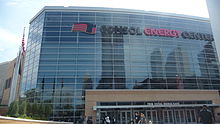 Consol Energy Center, current home of the Pittsburgh Penguins (first opened for the 2010–2011 NHL season).
Consol Energy Center, current home of the Pittsburgh Penguins (first opened for the 2010–2011 NHL season).
In 1967, the NHL doubled its teams from six to twelve and the Pittsburgh Penguins were born. The Penguins have won four Eastern Conference championships (1991, 1992, 2008, and 2009) and three Stanley Cup championships in 1991, 1992, and 2009. The Pens are owned by Hall of Famer Mario Lemieux, a back-to-back playoffs MVP for the Pens from 1984–2006. From 1967 until 2010 they played their home games at one of the NHL's oldest venues, and the first retractable domed stadium in the world, Civic Arena, or in local parlance "The Igloo". The Consol Energy Center replaced the "igloo" in the 2010–2011 NHL season. Robert Morris University also fields a Division I college hockey team at the RMU Island Sports Center, and much like 100 years ago, Pittsburgh is a hotbed for semi-pro and amateur teams, with the success of the Penguins fanning interest in the sport. The number of pro-grade ice rinks have increased in the region such as the Rostraver Ice Garden and Iceoplex at Southpointe, and several native Pittsburgh players have entered the NHL recently citing the success of Pens in the late 1980s and 1990s as spurring their interest in the sport.
Basketball
Professional basketball has played a role in the city's sports landscape since the 1910s, with "Monticello" and "Loendi" winning five national championships in the "Black Fives" league, the Pittsburgh Ironmen (inaugural season of the NBA), the Pittsburgh Rens (early 1960s), the Pittsburgh Pipers (first American Basketball Association championship in 1968), Pittsburgh Piranhas (CBA Finals in 1995), and recently the Pittsburgh Xplosion and Pittsburgh Phantoms (both of the ABA)
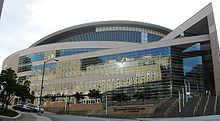 Petersen Events Center, home of Pittsburgh Panthers basketball
Petersen Events Center, home of Pittsburgh Panthers basketball
Collegiate basketball's fanbase was fueled since the early 20th century by the Dukes of Duquesne University and the Panthers of the University of Pittsburgh. During the 1940s to the 1970s, Duquesne was the city's most successful men's college basketball program. Appearing in the 1940 Final Four, the Dukes were the city's first college basketball team to obtain a number one ranking in the AP Poll in 1954,[132] and remain the only city team to have won a post-season college basketball tournament, the 1955 NIT, its second straight trip to the NIT title game. The Pitt Panthers won two pre-tournament era Helms Athletic Foundation National Championships in 1928 and 1930, competed in a "national title game" against LSU in 1935, and made a Final Four appearance in 1941. Since joining the Big East Conference in 1982, Pitt has regularly found a place among the top 25 NCAA teams, including a number one ranking for several weeks in 2009, and has made the NCAA Men's basketball tournament for the past nine seasons, reaching the Elite Eight ln 2009. Pitt plays at the Peterson Events Center, which has been sold out every season since its opening in 2002. The school's student section refers to itself as the "Oakland Zoo", a reference to the Oakland section of the city where the university is located. Pitt and Duquesne play a heated inter-city rivalry, termed "The City Game", each season. Since the 1970s, the suburban-based Robert Morris University's Colonials have also competed in NCAA Division I basketball. Located in Moon Township close to the Pittsburgh International Airport, the team has made the NCAA Tournament every decade since the 1980s, including in 2010, while posting several conference titles. Robert Morris also plays games against Duquesne and Pitt.
Other sports
Pittsburgh also hosts several annual major sporting events, including the Pittsburgh Marathon and the Great Race 10K, the Pittsburgh Vintage Grand Prix in motorsports, and with abundant rivers both the Head of the Ohio Regatta and the Three Rivers Regatta. The city's rivers also have been the reason the Forrest Wood Cup and the Bassmaster Classic chose Pittsburgh as host of their annual championships. Annual events continue during the winter months at area ski resorts such as Boyce Park, Seven Springs and Wisp as well as ice skating at PPG Place and North Park.
Golf has deep roots in the area with the region boasting the oldest course in continuous use in the nation: Foxburg Country Club dating from 1887. The Oakmont Country Club of suburban Oakmont has hosted more U.S. Open championships (eight) than any other course as well as two U.S. Women's Open championships, three PGA Championships, and eight U.S. Amateurs. Other area courses such as Laurel Valley Golf Club and the Pittsburgh Field Club have hosted PGA Championships, the Ryder Cup, LPGA Championships and Senior PGA Championships. The region has hosted annual PGA Tour events such as the 84 Lumber Classic (2001–2006) at Mystic Rock, the Pittsburgh Open (1950s) and the Pittsburgh Senior Classic (1993–1998) and since 2010 the annual Mylan Classic. Such golf legends as Arnold Palmer and Jim Furyk learned the game and began their careers on Pittsburgh area courses.
Pittsburgh has multiple mountain biking areas close to the city in area parks and in the surrounding suburbs. Frick Park has biking trails and Hartwood Acres Park has many miles of single track trails. A recent project, "Rails to Trails", has converted miles of former railroads to recreational trails, including a Pittsburgh-Washington D.C. bike/walking trail. Kayaking is popular on the city's three rivers.
Soccer in Pittsburgh is represented by the Pittsburgh Riverhounds, a professional soccer team playing in the second division of the United Soccer Leagues (USL). A first division team until 2004, the Riverhounds reached the 2001 US Open Cup quarterfinals after beating the Colorado Rapids of the Major League Soccer.
Pittsburgh is also represented by the Steel City Derby Demons, a roller derby team of the Women's Flat Track Derby Association.
Government
Main article: Government of PittsburghSee also: List of mayors of Pittsburgh, Pittsburgh Police Chief, and Allegheny County District Attorney The Pittsburgh City-County Building, seat of city and county government, at right, with the Allegheny County Courthouse designed by Henry Hobson Richardson, at left
The Pittsburgh City-County Building, seat of city and county government, at right, with the Allegheny County Courthouse designed by Henry Hobson Richardson, at left
Prior to the Civil War, Pittsburgh was largely in opposition to slavery. This sentiment culminated in Pittsburgh being selected as the birthplace of the national Republican Party, when the party held its first convention in February 1856. From the American Civil War to the 1930s, Pittsburgh was a Republican stronghold. However, national economic turmoil combined with entrenched local GOP scandals by the 1930s brought to an end Republican rule. In 1933, William N. McNair became the first Democrat to be elected mayor. With the exception of the 1973 and 1977 elections (where life-long Democrats ran off the party ticket), Democratic candidates have been elected consecutively to the mayor's office since the Great Depression. Today, the ratio of Democratic to Republican registrations within the city is 5 to 1.[133]
The mayor and the nine-member council serve a four-year term. The government's official offices are located in the Pittsburgh City-County Building. After the death of Mayor Bob O'Connor in September 2006, City Council President Luke Ravenstahl was sworn in as the mayor of Pittsburgh at age 26, becoming the youngest mayor in the history of any major American city.[134] He served until a special mayoral election was held in November 2007, when he was re-elected.[135]
City council members are chosen by plurality elections in each of nine districts. The members of the city council are: Darlene Harris (1), Theresa Kail-Smith (2), Bruce Kraus (3), Natalia Rudiak (4), Douglas Shields (5), R. Daniel Lavelle (6), Patrick Dowd (7), Bill Peduto (8), and Rev. Ricky Burgess (9).[136] The president of city council is Darlene Harris, who was elected to the position on January 4, 2010.[137]
Pittsburgh is represented in the Pennsylvania General Assembly by three Senate Districts and nine House Districts. Pittsburgh's State Senators include Jim Ferlo (38th District), Wayne D. Fontana (42), and Jay Costa (43). Representatives in the Pennsylvania House of Representatives include Jake Wheatley (19th District), Don Walko (20), Dominic Costa (21), Chelsa Wagner (22), Dan Frankel (23), Joseph Preston, Jr. (24), Dan Deasy (27), Paul Costa (34), and Harry Readshaw (36).
Federally, Pittsburgh is part of Pennsylvania's 14th congressional district, represented by Democrat Mike Doyle, elected in 1994. The Pittsburgh Police Bureau is the law enforcement arm of the city and the Pittsburgh Fire Bureau is a major emergency response unit in Western Pennsylvania. Pittsburgh EMS provides emergency medical, heavy rescue and river rescue services to the city.
By April 2008, the city and Allegheny County were discussing a plan to merge as early as 2009 in the interests of consolidating government and enhancing the status of the region.[138] If approved, the city of Pittsburgh would annex all of surrounding Allegheny County in a Metropolitan Government, and the population would stand at 1.2 million, making Pittsburgh the 10th largest city in the United States.[139] However, opposition to this plan is concerned of added bureaucracy of proposed "big government", inefficiencies and possible corruption will be extended to the newly-annexed communities resulting in a loss of services and an increase in taxes due to higher debt service costs of the city.
Education
The City of Pittsburgh is home to many colleges, universities and research facilities, the most well-known of which are Carnegie Mellon University, Duquesne University, and the University of Pittsburgh. Also located in the city are Carlow University, Chatham University, Point Park University, The Art Institute of Pittsburgh, and a branch campus of suburban Robert Morris University as well as the Community College of Allegheny County, The Pennsylvania Culinary Institute, and the Pittsburgh Institute of Mortuary Science. The greater Pittsburgh region boasts even more colleges and universities, including Clarion University of Pennsylvania, LaRoche College, Slippery Rock University, Westminster College and Grove City College north of the city, Robert Morris University and Geneva College west of the city, Washington & Jefferson College, California University of Pennsylvania and Waynesburg University to the south, and Seton Hill University, Saint Vincent College and Indiana University of Pennsylvania – the biggest state university – to the east.
The campuses of Carlow University, Carnegie Mellon University, and the University of Pittsburgh are located adjacent to each other in the Oakland neighborhood that is the traditional cultural and education center of the city. Carnegie Mellon University (CMU) is a private research university founded by Andrew Carnegie and is ranked #22 overall on US News & World Report list of America's Best National Universities.[140] Carnegie Mellon is known primarily for its computer science, engineering, business, economics, public policy, information systems, fine arts, and entrepreneurship programs. The University of Pittsburgh, established in 1787 and popularly referred to as "Pitt", is a state-related school with one of the country's largest research programs.[141][142] Pitt is ranked as the 19th national public university by US News & World Report and 57th overall, and is known for its programs in philosophy, international studies, information science, engineering, business, law, medicine, and other biomedical and health-related sciences.[140][143][144][145][146] Carlow University is a small private Roman Catholic university that while coeducational, has traditionally educated women. Chatham University, a liberal arts women's college with coeducational graduate programs, is located in the nearby Shadyside neighborhood, but also maintains a 400-acre (1.6 km2) Eden Hall Farm campus located in the North Hills. Duquesne University, a private Catholic university, is located in the Bluff neighborhood of Pittsburgh and is noted for its song and dance company, the Tamburitzans, as well as programs in law, business, and pharmacy. Point Park University, which recently announced a major expansion of its downtown campus, is the youngest university in the city and well known for its Conservatory of Performing Arts and its operation of the Pittsburgh Playhouse. Robert Morris University is based in the suburb of Moon Township, Pennsylvania and maintains a satellite center in downtown Pittsburgh.
Pittsburgh Public Schools teachers are paid well relative to their peers, ranking 17th in 2000 among the 100 largest cities by population for the highest minimum salary offered to teachers with a BA ($34,300).[citation needed] Pittsburgh ranked fifth in the highest maximum salary offered to teachers with an MA ($66,380).[citation needed] Local public schools include many charter and magnet schools, including City Charter High School (computer and technology focused), Pittsburgh Montessori School (formerly Homewood Montessori), Pittsburgh Gifted Center, Barack Obama Academy of International Studies 6-12, Pittsburgh Creative and Performing Arts 6–12, Pittsburgh Science and Technology Academy, and a school for the blind, The Western Pennsylvania School for the Deaf, or otherwise challenged children.
Private schools in Pittsburgh include North Catholic High School, Bishop Canevin High School, Seton-La Salle Catholic High School, Central Catholic High School, Oakland Catholic High School, Winchester Thurston School, and The Ellis School. Shady Side Academy, whose main campuses are located in Fox Chapel, has a junior high school in the neighborhood of Point Breeze.
The city also has an extensive library system, both public and university. Most notable are the Carnegie Library of Pittsburgh and the University of Pittsburgh's University Library System, which rank 9th-largest (public) and 18th largest (academic) in the nation, respectively.[147]
Media
Main articles: Media in Pittsburgh and List of films and television shows shot in PittsburghThere are two major daily newspapers in Pittsburgh: the liberal Pittsburgh Post-Gazette and the conservative Pittsburgh Tribune-Review. Alternative weekly papers in the region include the Pittsburgh City Paper, Pittsburgh Catholic, The Jewish Chronicle of Pittsburgh, The New People, and the New Pittsburgh Courier. Independent student-written university-based newspapers include The Pitt News of the University of Pittsburgh, The Tartan of Carnegie Mellon University, "The Duquesne Duke" of "Duquesne University", and The Globe of Point Park University. University of Pittsburgh School of Law is also home to JURIST, the world's only university-based legal news service.
The Pittsburgh metro area is served by many local television and radio stations. The Pittsburgh designated market area (DMA) is the 22nd largest in the U.S. with 1,163,150 homes (1.045% of the total U.S.).[148] The major network television affiliates are KDKA-TV 2 (CBS), WTAE 4 (ABC), WPXI 11 (NBC), WPGH-TV 53 (Fox), WPCW 19 (CW), WINP-TV 16 (ShopNBC), WPMY 22 (MyNetworkTV), and WPCB 40 (Cornerstone). WBGN 59 is an independent station owned and operated by the Bruno-Goodworth Network.
WQED 13 is the local PBS station in Pittsburgh. It was established on April 1, 1954, and was the first community-sponsored television station and the fifth public station in the United States. The station has produced much original content for PBS, including Mr. Rogers' Neighborhood, several National Geographic specials, and Where in the World is Carmen Sandiego?[149]
There are a wide variety of radio stations serving the Pittsburgh market. The first was KDKA 1020 AM, also the world's first commercially licensed radio station, airing on November 2, 1920.[150] Other popular stations include KQV 1410 AM (news), WBGG 970 AM (sports), KDKA-FM 93.7 FM (sports), WKST-FM 96.1 FM (pop and hip-hop), WBZZ 100.7 FM (adult contemporary), WDVE 102.5 FM (album rock), WPGB 104.7 FM (talk), and WXDX 105.9 FM (modern rock). There are also three public radio stations in the area; including WDUQ 90.5 FM (National Public Radio affiliate and jazz music station operated by Duquesne University), WQED 89.3 FM (classical), and WYEP 91.3 FM (adult alternative). Three non-commercial stations are run by Carnegie Mellon University (WRCT 88.3 FM), the University of Pittsburgh (WPTS 92.1 FM), and Point Park University (WPPJ 670 AM).
According to the Pittsburgh Film Office, over 123 major motion pictures have been filmed, in whole or in part, in Pittsburgh, including The Mothman Prophecies, Wonder Boys, Dogma, Hoffa, The Silence of the Lambs, and Zack and Miri Make a Porno. Pittsburgh also became "Gotham City" in 2011 for the filming of "The Dark Knight Rises (2012 release)."[151][152] Horror director George A. Romero, a Pittsburgh native, has shot nearly all of his films in and around Pittsburgh, including the majority of his Living Dead series. Showtime's popular series Queer as Folk is also set in Pittsburgh, although actual filming is done in Toronto.[153]
Infrastructure
Transportation
Main article: Transportation in PittsburghPittsburgh is a city of bridges with a total of 446.[13] Pittsburgh has three bridges more than Venice, Italy, which has historically held the title "City of Bridges."[154] Around 40 bridges cross the three rivers near the city. The southern "entrance" to Downtown is through the Fort Pitt Tunnel and over the Fort Pitt Bridge. The Panhandle Bridge carries the Port Authority's Blue/Red/Brown subway lines across the Monongahela River. Over 2,000 bridges span the landscape of Allegheny County.[155]
Expressways
Locals refer to the interstates fanning out from downtown Pittsburgh as the "parkways." I-376 is both the "parkway east" connecting to I-76 (Pennsylvania Turnpike) and the "parkway west" connecting to I-79, the Pittsburgh International Airport, the Ohio end of the Turnpike and I-80. The "parkway north" is I-279 connecting to I-79. The "crosstown" is I-579 allowing access to the heart of downtown, the Liberty Tunnels and the CONSOL Energy Center. Expressways such as Route 28 and Route 22 also carry traffic from downtown to the northeast and western suburbs, respectively. I-70, I-79 and I-76 (the Turnpike) roughly form a triangular-shaped "beltway" with I-80 and I-68 within the city's media market's northern and southern boundaries. Several suburban Turnpike spurs along the Monongahela River, the Airport and near Greensburg also help traffic flow. Navigation around the city and its suburbs can also be accomplished via the non-expressway Pittsburgh/Allegheny County Belt System.
A planned highway system called the Mon-Fayette/Southern Beltway project would allow access from the south and southwest of the city via a limited-access tolled expressway system.[156] The projects are in the planning stages with some sections already open to traffic. The projects are being planned by The Pennsylvania Turnpike Commission.[157]
Airports
The city is served by Pittsburgh International Airport (IATA: PIT) 17 miles (27 km) to the west in Findlay Township.[158] The airport was the long time major hub for US Airways from the company's start in the 1940s until the mid 2000's. In 2000, US Airways and its regional affiliates operated over 500 daily departures from Pittsburgh to more than 110 destinations; by 2007 fewer than 70 departures to 21 destinations remained.[159] However, in 2007, US Airways chose the city to house its new $25 million, 27,000 sq ft (2,500 m2). 600 employees strong Global Flight Operations Center, consolidating its two smaller (pre-merger) centers in Phoenix, Arizona and along I-376 in metro Pittsburgh. Currently, the largest promotions at the airport is the expansion of other airlines, particularly Delta Air Lines' new direct trans-Atlantic service to Paris as well as JetBlue and Southwest Airlines rapid expansion at the complex.
Art deco style Allegheny County Airport (AGC) handles 139,000 general aviation flights a year, and is located south of the city in West Mifflin. There are also smaller airports located near the city used primarily for corporate jets and other private aircraft: Rock Airport is northeast of Pittsburgh near the borough of Tarentum and Pittsburgh-Monroeville Airport is east of the city in Monroeville.
Commercial service is also available at suburban Arnold Palmer Regional Airport in the borough of Latrobe via Spirit Airlines and formerly Delta Air Lines and US Airways commuter service.
Several suburban private plane bases serve the region, the largest of these include Rostraver Airport and Pittsburgh-Monroeville Airport.
Public transportation
Port Authority of Allegheny County, commonly known as the Port Authority, but sometimes referred to by its former nickname "PAT" or "PAT Transit", is the region's mass transit system. While serving only a portion of the Pittsburgh area's 20th largest metro area it is the 11th largest transit agency in the nation. Port Authority runs a network of intracity and intercity bus routes, the Monongahela Incline funicular railway (more commonly known as an "incline") on Mount Washington, a light rail system that runs mostly above-ground in the suburbs and underground as a subway in the city, and one of the nation's largest busway systems.[160] The Duquesne Incline is operated by a non-profit preservation trust,[161] but it does accept Port Authority passes and charge standard Port Authority tolls.
The city has Amtrak intercity rail service via the Capitol Limited and the Pennsylvanian at Pennsylvania Station, also known as Union Station. Current freight railroads include CSX and Norfolk Southern. Enhancements to allow for highspeed rail transit connections to Philadelphia and the Northeast Corridor are underway as part of the American Recovery and Reinvestment Act of 2009.
Funding crisis of 2010–11
Between 2007 and 2010, the Port Authority cut its annual expenses by $52 million and raised its revenues by $14 million to help alleviate a statewide transportation funding crisis.[162] The funding crisis only grew worse, however. The state legislature assumed it would receive permission to convert Interstate 80 into a toll road to increase revenues, but the federal government denied the request, leading to a gap in the state transportation budget of $472 million.[163]
On November 24, 2010, the Port Authority's board of directors approved a massive service cut and fare hike to go into effect in March 2011. The service cut would reduce total service hours by approximately 35 percent, including the elimination of 45 routes.[162] The Port Authority's budget from the state is to be substantially reduced for 2011, and as chairperson Joan Ellenbogen noted, the Port Authority is legally required to adopt a balanced budget.[164] Chairperson Guy Mattola stated that "Unfortunately, we are now at the point that all options have been exhausted...It is necessary to move forward with this service reduction plan recognizing the devastating consequences for riders and non-riders alike."[165]
On December 13, 2010, the Southwestern Pennsylvania Commission approved a plan by governor Ed Rendell to allocate $45 million in temporary funding for the Port Authority to help reduce the magnitude of these service cuts.[166] Ultimately, service was cut 15% effective March 27, 2011.[107]
Utilities
Further information: Allegheny County Sanitary AuthorityThe city is served by Duquesne Light, one of the original power companies founded in 1912 by George Westinghouse. Water utility service is provided by the Pittsburgh Water and Sewer Authority[167] and Pennsylvania American Water.
Natural gas is widely used in the area due to large reserves existing in the region. Service in Pittsburgh is provided by Equitable Gas and Columbia Gas. Both companies offer "Customer Choice" programs in which residents may choose alternative natural gas suppliers who work under an agreement to provide natural gas in smaller service areas; these companies include Dominion Peoples Plus, Direct Energy Services LLC, and Novec Energy Solutions.[citation needed]
Health care
See also: List of hospitals in PittsburghThe two largest health care providers are the University of Pittsburgh Medical Center and West Penn Allegheny Health System, respectively.
Sister cities
Pittsburgh has seventeen sister cities:[168][169]
 Hamilton, Ontario, Canada
Hamilton, Ontario, Canada Bilbao, Spain
Bilbao, Spain Charleroi, Belgium
Charleroi, Belgium Da Nang, Vietnam
Da Nang, Vietnam Donetsk, Ukraine
Donetsk, Ukraine Fernando de la Mora, Paraguay
Fernando de la Mora, Paraguay Karmiel, Israel
Karmiel, Israel Matanzas, Cuba
Matanzas, Cuba Misgav, Israel
Misgav, Israel Ostrava, Czech Republic
Ostrava, Czech Republic Prešov, Slovakia
Prešov, Slovakia Novokuznetsk, Russia
Novokuznetsk, Russia
 Terrassa, Spain
Terrassa, Spain Saarbrücken, Germany
Saarbrücken, Germany Saitama (Omiya-ku, formerly Omiya city[170]), Japan
Saitama (Omiya-ku, formerly Omiya city[170]), Japan San Isidro, Nicaragua
San Isidro, Nicaragua Sheffield, United Kingdom
Sheffield, United Kingdom Skopje, Macedonia[171][172]
Skopje, Macedonia[171][172] Sofia, Bulgaria
Sofia, Bulgaria Wuhan, People's Republic of China
Wuhan, People's Republic of China Zagreb, Croatia
Zagreb, Croatia Rijeka, Croatia
Rijeka, Croatia Melbourne, Australia[citation needed]
Melbourne, Australia[citation needed]
See also
- Pittsburgh (disambiguation)
- Allegheny, Pennsylvania
- List of municipalities in Pennsylvania
- List of people from the Pittsburgh metropolitan area
- All pages beginning with "Pittsburgh"
Notes
- ^ The two remaining steel mills are the Edgar Thomson Steel Works and Brackenridge Works. A few related facilities such as the Clairton Works (a coking plant) and the Irvin Plant (a finishing plant) also reside within Allegheny County, but these are not steel mills per se because they do not produce steel. See the list of US Steel facilities for details.
- ^ Although medical research is often cited as a recent addition to Pittsburgh's economic portfolio, major advances go back several decades. Working at the University of Pittsburgh in the 1950s, Jonas Salk developed the first successful vaccine for large-scale immunization against poliomyelitis (a.k.a. polio or infantile paralysis). Also, several types of organ transplants were pioneered in Pittsburgh by Dr. Thomas Starzl beginning in 1983. Pittsburgh's hospitals and universities remain the hosts for some of the premier medical research facilities in the world.
- ^ The neighborhoods are Arlington Heights, Bluff, Brighton Heights, Crafton Heights, Duquesne Heights, East Hills, Fineview, Highland Park, Middle Hill, Mount Oliver, Mount Washington, Northview Heights, Perry North (also known as Observatory Hill), Perry South (also known as Perry Hilltop), Polish Hill, Ridgemont, South Side Slopes, Spring Hill-City View, Squirrel Hill, Stanton Heights, Summer Hill, Troy Hill, and Upper Hill.
References
- ^ O'Brien, Jim; Marty Wolfson (1980). Pittsburgh, the story of the city of champions: the '70s—a decade unmatched in the annals of sports. Wolfson Pub. Co.. ISBN 978-0-916114-07-7.
- ^ Scarpaci, Joseph L; Kevin Joseph Patrick (2006). "Chapter 6: Pittsburgh, City of Bridges". Pittsburgh and the Appalachians: cultural and natural resources in a postindustrial age. Pittsburgh: University of Pittsburgh Press. p. 81. ISBN 978-0-8229-4282-5. http://books.google.com/?id=9qTdSl2CkzkC&pg=PA81&dq=pittsburgh+%22city+of+champions%22&cd=1#v=onepage&q=. Retrieved 28 February 2010.
- ^ Rossi, Rob (14 February 2010). "Deadline-day deal? Not likely for Penguins". Pittsburgh Tribune-Review. http://www.pittsburghlive.com:8000/x/pittsburghtrib/sports/s_667140.html. Retrieved 28 February 2010.
- ^ a b c Bobkoff, Dan (16 December 2010). "From Steel To Tech, Pittsburgh Transforms Itself". NPR. http://www.npr.org/2010/12/16/131907405/from-steel-to-tech-pittsburgh-transforms-itself. Retrieved 21 December 2010.
- ^ "Historic Pittsburgh Chronology by Decade: 1717–1749". University of Pittsburgh. October 2, 2009. http://digital.library.pitt.edu/cgi-bin/chronology/chronology_driver.pl?searchtype=dbrowse&year=1717&year2=1749. Retrieved October 2, 2009.
- ^ "U.S. Census Bureau Delivers Pennsylvania's 2010 Census Population Totals, Including First Look at Race and Hispanic Origin Data for Legislative Redistricting". http://www.census.gov/newsroom/releases/archives/2010_census/cb11-cn74.html. Retrieved 11 March 2011.
- ^ Giammarise, Kate (November 8, 2009). "Pittsburgh: The Paris of Appalachia". Rust Wire. http://rustwire.com/2009/11/08/pittsburgh-the-paris-of-appalachia/. Retrieved July 1, 2011.
- ^ "Find a County". National Association of Counties. http://www.naco.org/Counties/Pages/FindACounty.aspx. Retrieved 2011-06-07.
- ^ Bowling, Brian (24 March 2010). "Census: More people arrive than leave for first time in almost 20 years". Pittsburgh Tribune-Review. http://www.pittsburghlive.com/x/pittsburghtrib/news/pittsburgh/s_673090.html. Retrieved 1 October 2010.
- ^ Lord, Rich (March 10, 2011). "Pittsburgh region's population loss slows slightly in 10 years". Pittsburgh Post-Gazette. http://www.post-gazette.com/pg/11069/1130976-455.stm.
- ^ Miller, Harold (August 3, 2008). "Regional Insights: Pittsburgh is a national player in jobs per square mile but needs more population". Pittsburgh Post-Gazette. http://www.post-gazette.com/pg/08216/901307-432.stm. Retrieved August 6, 2008.
- ^ "High-rise Buildings of Pittsburgh". Emporis.com. http://www.emporis.com/en/wm/ci/bu/sk/?id=101313. Retrieved April 11, 2009.
- ^ a b "Pittsburgh has Plenty of Bridges". KDKA-TV. June 16, 2006. http://kdka.com/local/bridge.Pittsburgh.2.383456.html. Retrieved July 8, 2009.[dead link]
- ^ Strand, Ginger (September/October 2009). "Beautiful Ruination". Orion Magazine. http://www.orionmagazine.org/index.php/articles/article/4938/. Retrieved 21 December 2010.
- ^ Lynch, David J. (22 September 2009). "Pittsburgh's heart of steel still beats amid transformed city". USA Today. http://www.usatoday.com/money/economy/2009-09-21-us-steel-pittsburgh_N.htm.
- ^ Hoerr, John P. (1988). And the wolf finally came: the decline of the American steel industry. Univ of Pittsburgh Press. p. 1. ISBN 978-0-8229-5398-2. http://books.google.com/books?id=yDcoA4YsnqIC&pg=PA1. Retrieved 7 September 2010.
- ^ Streitfeld, David (8 January 2009). "Survival Lesson in Pittsburgh: Shedding an Industrial Past". The New York Times: p. 1. http://www.nytimes.com/2009/01/08/business/economy/08collapse.html. Retrieved 7 September 2010.
- ^ Napsha, Joe (August 2, 2008). "Growth of jobs locally bucks nationwide trend". Pittsburgh Tribune-Review. http://www.pittsburghlive.com/x/pittsburghtrib/business/s_580675.html. Retrieved August 6, 2008.
- ^ a b Dan Majors (April 26, 2007). "Pittsburgh rated 'most livable' once again". Pittsburgh Post-Gazette. http://post-gazette.com/pg/07116/781162-53.stm.
- ^ a b America's Most Livable Cities – Forbes.com
- ^ a b Percha, Julie (February 22, 2011). "Move over, Honolulu; Pittsburgh's No. 1 in U.S.". Pittsburgh Post-Gazette (Pittsburgh, PA). http://www.post-gazette.com/pg/11053/1127102-53.stm. Retrieved February 22, 2011.
- ^ "Edinburgh Doesn't Rhyme With Pittsburgh – A Guide to Scottish Placenames". Rampant Scotland. http://www.rampantscotland.com/features/pronounce2.htm. Retrieved April 6, 2010.
- ^ How to Spell Pittsburgh, Carnegie Library of Pittsburgh. Retrieved January 18, 2009.
- ^ Van Trump, James. "The Controversial Spelling of "Pittsburgh", or Why The "H"?". Pittsburgh History & Landmarks Foundation. http://www.phlf.org/2000/12/21/the-controversial-spelling-of-pittsburgh-or-why-the-h/. Retrieved 19 February 2010.
- ^ Boehmig, Stuart P. (2007). "3: A City Emerges from a Frontier Town". Downtown Pittsburgh. San Francisco, CA: Arcadia Publishing. p. 29. ISBN 978-0-7385-5042-8. http://books.google.com/?id=bz1Sm7WJ4ikC&pg=PA39&dq=pittsburgh+pittsburro&cd=1#v=onepage&q=. Retrieved 19 February 2010.
- ^ Bannon, Shawn; Jason Coll and Bill Flanagan (21 February 2008). "The Naming of Pittsburgh". YouTube. http://www.youtube.com/watch?v=omaJWkm24Rk. Retrieved 19 February 2010.
- ^ "Pittsburgh Facts". Pittsburgh Post-Gazette. January 1, 2003. http://www.post-gazette.com/pg/03001/700027-209.stm. Retrieved October 21, 2007.
- ^ a b "How to Spell Pittsburgh". Carnegie Library of Pittsburgh. http://www.carnegielibrary.org/exhibit/hname2.html. Retrieved September 22, 2006.
- ^ "Most Misspelled Cities in America". http://www.epodunk.com/top10/misspelled/index.html. Retrieved October 21, 2007.
- ^ "friendsoftheriverfront.org". Friendsoftheriverfront.org. Archived from the original on January 11, 2089. http://web.archive.org/web/20080111125520/http://www.friendsoftheriverfront.org/new_pages/historical.htm. Retrieved January 5, 2009.
- ^ a b "Pittsburgh Chronology". Digital.library.pitt.edu. http://digital.library.pitt.edu/cgi-bin/chronology/chronology_driver.pl?searchtype=dbrowse&year=1717&year2=1749. Retrieved April 11, 2009.
- ^ a b Lorant, Stefan (1999). Pittsburgh, The Story of an American City (5th ed.). Esselmont Books, LLC.. ISBN 978-0-685-92012-1.
- ^ d'Errico, Peter. "Jeffrey Amherst and Smallpox Blankets: Lord Jeffrey Amherst's letters discussing germ warfare against American Indians". Nativeweb. http://www.nativeweb.org/pages/legal/amherst/lord_jeff.html. Retrieved August 12, 2009.
- ^ a b Chamber of Commerce of Pittsburgh (1921). Pittsburgh First, the Official Organ of The Chamber of Commerce of Pittsburgh.
- ^ Ballou's Pictorial, issue of 21 February 1857
- ^ "Kids' Corner: 1910–30 saw huge black migration". Pittsburgh Post-Gazette. February 18, 2003.
- ^ Kalson, Sally (November 19, 2003). "Cartoonist draws, fires a blank with Pittsburgh joke". Pittsburgh Post-Gazette. http://www.post-gazette.com/columnists/20031119sally104col2p2.asp.
- ^ "US to host next G20 world meeting". BBC News. May 28, 2009. http://news.bbc.co.uk/2/hi/business/8072894.stm. Retrieved May 22, 2010.
- ^ Patricia Lowry (March 16, 2004). "Learning the steps: Pitt researcher fell for city's stairs and has published a book that maps them". Pittsburgh Post-Gazette. http://www.post-gazette.com/pg/04076/286278.stm.
- ^ "The Steps of Pittsburgh: Portrait of a City" by Bob Regan, photos by Tim Fabian, published by The Local History Company, Pittsburgh, ISBN 978-0-9711835-6-8
- ^ a b c "NCDC: U.S. Climate Normals" (PDF). National Oceanic and Atmospheric Administration. http://cdo.ncdc.noaa.gov/climatenormals/clim20/pa/366993.pdf. Retrieved May 11, 2010.
- ^ "Cloudiness – Mean Number of Days". National Climatic Data Center. 20 August 2008. http://www.ncdc.noaa.gov/oa/climate/online/ccd/cldy.html. Retrieved 15 May 2011.
- ^ "RANKING OF CITIES BASED ON % ANNUAL POSSIBLE SUNSHINE IN DESCENDING ORDER FROM MOST TO LEAST AVERAGE POSSIBLE SUNSHINE". National Climatic Data Center. http://www.ncdc.noaa.gov/oa/climate/online/ccd/pctposrank.txt. Retrieved 15 May 2011.
- ^ "Blizzard of 1993". Pittsburgh Public Works. http://www.city.pittsburgh.pa.us/pw/html/blizzard_of_1993.html. Retrieved 5 June 2010.
- ^ "2010: A Pittsburgh Snow Odyssey". Pittsburgh Post-Gazette. http://www.thepittsburghchannel.com/weather/22687306/detail.html. Retrieved 5 June 2010.
- ^ "Climatological Normals of Pittsburgh". Hong Kong Observatory. http://www.hko.gov.hk/wxinfo/climat/world/eng/n_america/us/pittsburgh_e.htm. Retrieved 2010-05-11.
- ^ "Average weather for Pittsburgh International Airport, PA - Temperature and Precipitation". The Weather Channel. http://www.weather.com/outlook/travel/businesstraveler/wxclimatology/monthly/graph/PIT:9. Retrieved 2011-09-15.
- ^ a b "Allegheny County and Pittsburgh-New Castle, PA". State of the Air 2011. American Lung Association. 2011. http://www.stateoftheair.org/2011/states/pennsylvania/allegheny-42003.html. Retrieved 7 May 2011.
- ^ "Pittsburgh Air Quality No Longer Worst In U.S.". WPXI. 28 April 2010. http://www.wpxi.com/news/23287732/detail.html. Retrieved 7 May 2011.
- ^ The Most Polluted Places in America – 3 Living Green – Your Life - MSN Lifestyle
- ^ Heinrichs, Allison. "Region passes L.A. on pollution list". Pittsburgh Tribune Review. http://www.pittsburghlive.com/x/pittsburghtrib/news/cityregion/s_565183.html. Retrieved August 10, 2008.
- ^ "Golden Triangle (Pittsburgh)". Emporis.com. http://www.emporis.com/en/wm/bo/?id=102614. Retrieved April 11, 2009.
- ^ "Pittsburgh Neighborhoods". City of Pittsburgh Portal. http://www.city.pittsburgh.pa.us/portal/neighborhoods.html. Retrieved July 17, 2007.
- ^ "U.S. Steel Tower, Pittsburgh". Emporis Buildings. http://www.emporis.com/en/wm/bu/?id=usouthsteeltower-pittsburgh-pa-usa. Retrieved July 17, 2007.
- ^ http://www.portauthority.org/PAAC/Portals/Capital/NorthShore/images/big-new-map.JPG
- ^ "American Eagle Outfitters Announces Pittsburgh's SouthSide Works Location As New Corporate Headquarters". Business Wire. October 21, 2005. http://findarticles.com/p/articles/mi_m0EIN/is_2005_Oct_21/ai_n15726879. Retrieved October 21, 2007.
- ^ a b http://factfinder.census.gov/servlet/ACSSAFFFacts?_event=ChangeGeoContext&geo_id=16000US4261000&_geoContext=&_street=&_county=Pittsburgh%2C+PA&_cityTown=Pittsburgh%2C+PA&_state=&_zip=&_lang=en&_sse=on&ActiveGeoDiv=&_useEV=&pctxt=fph&pgsl=010&_submenuId=factsheet_1&ds_name=ACS_2009_5YR_SAFF&_ci_nbr=null&qr_name=null®=null%3Anull&_keyword=&_industry=
- ^ "American FactFinder". United States Census Bureau. http://factfinder.census.gov. Retrieved 2008-01-31.
- ^ "Pittsburgh city, Pennsylvania: ACS Demographic and Housing Estimates: 2005–2007". 2006–2008 American Community Survey 3-Year Estimates. US Census Bureau. http://factfinder.census.gov/servlet/ACSSAFFFacts?_event=&geo_id=16000US4261000&_geoContext=01000US. Retrieved 30 May 2009.
- ^ "Statistics". 64.233.169.104. March 29, 2009. http://64.233.169.104/search?q=cache:0eQjgx5x1eQJ:www.niaf.org/research/statistics2.asp+u.s.+cities+italian+population&hl=en&ct=clnk&cd=1&gl=us&client=firefox-aPittsburgh. Retrieved April 12, 2009.
- ^ Wolowyna, Oleh (January 9, 2000). "Demographic, social, cultural characteristics of persons of Ukrainian ancestry in Chicago". The Ukrainian Weekly No. 2, Vol. LXVIII. http://www.ukrweekly.com/old/archive/2000/020012.shtml. Retrieved May 16, 2008. (based on 1990 US Census)
- ^ "U.S. Census Bureau: American Community Survey (ACS): Percent of People 25 Years and Over Who Have Completed a Bachelor's Degree: Population 25 years and over (Place level)". Census.gov. August 22, 2007. Archived from the original on April 18, 2008. http://web.archive.org/web/20080418125331/http://www.census.gov/acs/www/Products/Ranking/2002/R02T160.htm. Retrieved April 11, 2009.
- ^ "U.S. Census Bureau: American Community Survey (ACS): Percent of People 25 Years and Over Who Have Completed High School (Including Equivalency): Population 25 years and over (Place level)". Census.gov. August 22, 2007. Archived from the original on January 3, 2008. http://web.archive.org/web/20080103153128/http://www.census.gov/acs/www/Products/Ranking/2002/R13T160.htm. Retrieved April 11, 2009.
- ^ "Pittsburgh Crime Statistics (PA) – CityRating.com". Cityrating.com. http://www.cityrating.com/citycrime.asp?city=Pittsburgh&state=PA. Retrieved January 5, 2009.
- ^ a b Greenburg, Zack O'Malley (26 October 2009). "Full List: America's Safest Cities". Forbes. http://www.forbes.com/2009/10/26/safest-cities-ten-lifestyle-real-estate-metros-msa_chart.html?partner=yahoore. Retrieved October 28, 2009.
- ^ City crime Rankings : 2008–2009, C Q Press.
- ^ About Our Region Pittsburgh Technology Council
- ^ "Bakery Square at Eastside, Pittsburgh :: Commercial, Residential Hotel Development". Walnut Capital and RCG Longview Fund. http://bakery-square.com/. Retrieved 8 December 2010.
- ^ Moore, Andrew (8 December 2010). "It’s a beautiful day in this neighborhood: growing in Pittsburgh". The Official Google Blog. Google. http://googleblog.blogspot.com/2010/12/its-beautiful-day-in-this-neighborhood.html. Retrieved 8 December 2010.
- ^ Belko, Mark; Erich Schwartzel (8 January 2011). "Google leases more space at Bakery Square". Pittsburgh Post-Gazette. http://www.post-gazette.com/pg/11008/1116375-28.stm. Retrieved 7 February 2011.
- ^ Erdley, Debra. "Irish view Pittsburgh's comeback as their pot of gold". Pittsburgh Tribune-Review. http://www.pittsburghlive.com/x/pittsburghtrib/business/s_739819.html. Retrieved 3 June 2011.
- ^ Miller, Harold D. (5 December 2010). "Pittsburgh's Future: Thank Seniors for Helping Us Get Through the Recession". Pittsburgh's Future: Making Southwestern Pennsylvania One of the World's Greatest Regions. http://pittsburghfuture.blogspot.com/2010/12/thank-seniors-for-helping-us-get.html. Retrieved 8 December 2010.
- ^ "Top Private Employers". Pittsburgh Regional Alliance. Archived from the original on October 10, 2006. http://web.archive.org/web/20061010050140/http://www.alleghenyconference.org/public/cfm/d_and_d/index.cfm. Retrieved April 14, 2007.
- ^ "Fortune 500: Cities with Five or More Fortune 500 Headquarters". Fortune. April 2007. http://money.cnn.com/magazines/fortune/fortune500/2007/cities/.
- ^ "2006 MAYOR'S CHALLENGE: Where Are the Best Metros for Future Business Locations?". Expansion Magazine. August 7, 2006. http://www.expansionmanagement.com/smo/newsviewer/default.asp?cmd=articledetail&articleid=17713&st=3.
- ^ "Fortune 500 2010". Fortune. April 15, 2010. http://money.cnn.com/magazines/fortune/fortune500/2010/states/PA.html.
- ^ Arts and Economic Impact III[dead link]
- ^ Green, Elwin (6 December 2009). "Natural gas locked in the Marcellus Shale has companies rushing to cash in on possibilities". Pittsburgh Post-Gazette. http://www.post-gazette.com/pg/09340/1018586-28.stm. Retrieved 28 February 2010.
- ^ "Pitt: Land leased for oil, gas up 322 percent". The Associated Press; hosted by Google. 16 August 2010. http://www.google.com/hostednews/ap/article/ALeqM5hstlzVCvbYCMG7AirNjE4AaLp2jgD9HKNI5G1. Retrieved 17 August 2010.[dead link]
- ^ Rap Radar :: Wiz Khalifa “Black & Yellow” Hits Number One
- ^ http://www.billboard.com/#/charts/hot-100
- ^ George Benson
- ^ Rachel Louise Carson
- ^ Sherman, Jerome L. (December 16, 2006). "Presidential biographer gets presidential medal". Pittsburgh Post-Gazette. http://www.post-gazette.com/pg/06350/746640-44.stm. Retrieved June 8, 2008.
- ^ Hayes, John (October 11, 1998). "The write stuff". Post-gazette.com. http://www.post-gazette.com/magazine/19981011playw2.asp. Retrieved January 5, 2009.
- ^ "Welcome to Chiller Theater Memories!". Chillertheatermemories.com. http://www.chillertheatermemories.com. Retrieved January 5, 2009.
- ^ "Rusty Cundieff". Nndb.com. December 30, 2003. http://www.nndb.com/people/361/000045226. Retrieved January 5, 2009.
- ^ "SAVINI.COM: The Official Tom Savini Home page". Savini.com. http://www.savini.com. Retrieved January 5, 2009.
- ^ "PARSEC: Pittsburgh's Premiere Science Fiction Organization". Parsec-sff.org. November 5, 2006. http://www.parsec-sff.org/links.html. Retrieved January 5, 2009.
- ^ http://word.pghfree.net/ Write or Die
- ^ "Pittsburgh South Writes Homepage". Interzone.com. Archived from the original on October 25, 2007. http://web.archive.org/web/20071025142835/http://www.interzone.com/~jafriedl/SW/sowrites.htm. Retrieved January 5, 2009.
- ^ "Pittsburgh Worldwrights". Cs.cmu.edu. May 27, 2005. http://www.cs.cmu.edu/~mslee/pw.html/. Retrieved January 5, 2009.[dead link]
- ^ Rodger Turner, Webmaster. "The SF Site: A Conversation With Mary Soon Lee". Sfsite.com. http://www.sfsite.com/02b/msl122.htm. Retrieved January 5, 2009.
- ^ "Revenant: The Premiere Zombie Magazine – Features". Revenantmagazine.com. http://www.revenantmagazine.com/MarkMenoldinterview.htm. Retrieved January 5, 2009.[dead link]
- ^ Sultan, Tim (March 17, 2006). "It's Not the Sights, It's the Sounds". New York Times: p. 2. http://travel2.nytimes.com/2006/03/17/travel/escapes/17accent.html?pagewanted=2. Retrieved August 14, 2007.
- ^ "Overview". Pittsburgh Speech and Society. http://english.cmu.edu/pittsburghspeech/overview.html. Retrieved August 14, 2007.
- ^ Carpenter, Mackenzie (June 10, 2009). "Pittsburgh ranked tops in U.S. by The Economist". Pittsburgh Post-Gazette. http://www.post-gazette.com/pg/09161/976252-53.stm. Retrieved June 10, 2009.
- ^ America's Most Livable Cities 2010 – Yahoo! Real Estate
- ^ Smydo, Joe (8 June 2010). "Pittsburgh named 7th best place to raise a family". Pittsburgh Post-Gazette. http://www.pittsburghpostgazette.com/pg/10159/1064054-100.stm. Retrieved 4 July 2010.
- ^ Casserly, Meghan (July 26, 2010). "The Best Cities For Working Mothers, 2010". Forbes. http://www.forbes.com/2010/07/24/best-us-cities-working-mothers-employment-family-forbes-woman-leadership-parenting.html.
- ^ Innovation Nation
- ^ Malone, Robert. "World's Cleanest Cities". Forbes. http://www.forbes.com/2007/04/16/worlds-cleanest-cities-biz-logistics-cx_rm_0416cleanest_slide_16.html.
- ^ "Rent Jungle Statistics". http://www.rentjungle.com/average-rent-in-pittsburgh-rent-trends/.html. Retrieved 18 October 2010.
- ^ a b c Puko, Tim (17 May 2010). "Huge flood-control cost, planning mess put Southwestern Pennsylvania in bind – Pittsburgh Tribune-Review". Pittsburgh Tribune-Review. http://www.pittsburghlive.com/x/pittsburghtrib/news/regional/s_681477.html. Retrieved 1 December 2010.
- ^ Stephenson, Philip A. (15 September 2005). "Damage repaired, trauma remains after 2004 floods". Pittsburgh Post-Gazette. http://www.post-gazette.com/pg/05258/571483-54.stm. Retrieved October 28, 2009.
- ^ Anderson, R.M.; Beer, K.M., Buckwalter, T.F., Clark, M.E., McAuley, S.D., Sams, J.I. III, and Williams, D.R. (2000). "Water Quality in the Allegheny and Monongahela River Basins Pennsylvania, West Virginia, New York, and Maryland, 1996–98". U.S. Geological Survey Circular (1202). http://pubs.usgs.gov/circ/circ1202/introduction.htm.
- ^ a b Barcousky, Len (17 March 2011). "Two recall encountering Pittsburgh's historic 1936 flood". Pittsburgh Post-Gazette. http://www.post-gazette.com/pg/11076/1132569-455.stm. Retrieved 17 March 2011.
- ^ a b c Scarpaci, Joseph L.; Patrick, Kevin Joseph (June 28, 2006). Pittsburgh and the Appalachians: cultural and natural resources in a postindustrial age. University of Pittsburgh Pre. ISBN 9780822942825. http://books.google.com/books?id=9qTdSl2CkzkC. Retrieved 3 February 2011.
- ^ a b c O'Neill, Brian (2009). The Paris of Appalachia: Pittsburgh in the Twenty-first Century. Carnegie Mellon University Press. ISBN 978-0-88748-509-1.
- ^ Behe, Regis (3 March 2006). "Steel city an unlikely haven for writers". Pittsburgh Tribune-Review. http://www.pittsburghlive.com/x/pittsburghtrib/s_429269.html. Retrieved 7 February 2011.
- ^ "CAVALIERS: The Optimist". National Basketball Association. http://www.nba.com/cavaliers/features/optimist_pittsburgh_101013.html. Retrieved 7 February 2011.
- ^ Watson, Bruce (2 December 2010). "America's 11 Best Cities for Telecommuters". DailyFinance. http://www.dailyfinance.com/story/real-estate/the-11-best-cities-for-telecommuters/19713087/. Retrieved 7 February 2011.
- ^ "Census Regions and Divisions of the United States". U.S. Census Bureau. http://www.census.gov/geo/www/us_regdiv.pdf. Retrieved 24 July 2010.
- ^ Mostrous, Alexi (24 September 2009). "Pittsburgh, Site of G-20 Summit, Is Shaking Off Its Smoky Image". The Washington Post. http://www.washingtonpost.com/wp-dyn/content/article/2009/09/23/AR2009092304713.html. Retrieved 9 February 2011.
- ^ "Who we are". Great Lakes Metro Chambers Coalition. http://greatlakesmetrochambers.com/WhoWeAre.aspx. Retrieved 9 February 2011.
- ^ "Great Lakes – America 2050". America 2050. http://www.america2050.org/great_lakes.html. Retrieved 9 February 2011.
- ^ a b c Briem, Christopher (2 January 2011). "Welcome to Cleveburgh! Pittsburghers need to rethink their place in the world". Pittsburgh Post-Gazette. http://www.post-gazette.com/pg/11002/1114678-109.stm. Retrieved 24 January 2011.
- ^ Briem, Christopher (2 January 2011). "A Turnpike Runs Through It". Null Space. http://nullspace2.blogspot.com/2011/01/turnpike-runs-through-it.html. Retrieved 1 February 2011.
- ^ Briem, Christopher (22 January 2011). "Residents of Cleveland and Pittsburgh need to rethink their place in the world". The Plain Dealer. http://www.cleveland.com/opinion/index.ssf/2011/01/residents_of_cleveland_and_pit.html. Retrieved 1 February 2011.
- ^ Roman, Joe; Dennis Yablonsky (23 January 2011). "Tech Belt Initiative helps area compete in global markets:". The Plain Dealer. http://www.cleveland.com/opinion/index.ssf/2011/01/tech_belt_initiative_helps_are.html. Retrieved 17 October 2011.
- ^ "Cleveburgh". Crain's Cleveland Business. 23 April 2007. http://www.crainscleveland.com/article/20070423/SUB/70420005. Retrieved 17 October 2011.
- ^ a b c Carlisle, Anthony Todd (20 January 2011). "A newsmaker you should know: He's expanding power of community". Pittsburgh Post-Gazette. http://www.post-gazette.com/pg/11020/1119147-56.stm. Retrieved 24 January 2011.
- ^ "About P32". http://www.powerof32.org/about-p32. Retrieved 24 January 2011.
- ^ "Get Informed.". http://www.powerof32.org/get-informed. Retrieved 31 January 2011.
- ^ Hille, Bob (6 October 2009). "Black & Gold mettle: Pittsburgh is Best Sports City – Bob Hille – College Basketball – Sporting News". Sporting News. http://www.sportingnews.com/mlb/article/2009-10-06/black-gold-mettle-pittsburgh-best-sports-city-0. Retrieved 12 July 2010.
- ^ The Pittsburgh Power of the Arena Football League and the Pittsburgh Passion of the IWFL use these colors as well.
- ^ Jim Caple. "Pittsburgh's gem rates the best". ESPN.com. http://espn.go.com/page2/s/ballparks/pncpark.html. Retrieved July 9, 2008.
- ^ John Perrotto (August 14, 2006). "Baseball Plog". Beaver County Times. http://www.timesonline.com/site/news.cfm?newsid=17047895&BRD=2305&PAG=461&dept_id=478568&rfi=6.
- ^ "ESPN ranks Steelers fans No. 1". Pittsburgh Tribune-Review. August 30, 2008. http://www.pittsburghlive.com/x/pittsburghtrib/sports/steelers/s_585606.html?source=rss&feed=3. Retrieved August 30, 2008.
- ^ Rossi, Rob (August 20, 2010). "Pittsburgh Power unveiled as arena football expansion team". Pittsburgh Tribune-Review. http://www.pittsburghlive.com/x/pittsburghtrib/sports/s_695755.html. Retrieved August 20, 2010.
- ^ See page 67 of the NCAA Men's College Basketball Records (PDF file)
- ^ "Pittsburgh, Pennsylvania – Transatlantic Cities Network". The German Marshall Fund of the United States. http://www.gmfus.org/template/page.cfm?page_id=481. Retrieved May 6, 2009.
- ^ "Ravenstahl Among Youngest Mayors Ever" (video). KDKA-TV. September 4, 2006. http://kdka.com/video/?id=19751@kdka.dayport.com. Retrieved August 20, 2007.[dead link]
- ^ Gary Rotstein (October 13, 2006). "Ravenstahl must run next year". Pittsburgh Post-Gazette. http://www.postgazette.com/pg/06286/729694-182.stm. Retrieved August 20, 2007.
- ^ "City Council." City of Pittsburgh (official website). Retrieved on May 19, 2008.
- ^ "Darlene Harris wins City Council presidency" (article). Pittsburgh Post-Gazette. January 4, 2010. http://www.postgazette.com/pg/10004/1025697-455.stm. Retrieved January 4, 2010.
- ^ "kdka.com – Local Officials Look For Ways To Improve City-County Merger Recommendation". Kdka.com. April 4, 2008. Archived from the original on April 8, 2008. http://web.archive.org/web/20080408151806/http://kdka.com/politics/Pittsburgh.Allegheny.County.2.692217.html. Retrieved January 5, 2009.
- ^ "thepittsburghchannel.com – Pittsburgh-Allegheny County Merger Recommended". ThePittsburghChannel.com. April 3, 2008. http://www.thepittsburghchannel.com/news/15782593/detail.html. Retrieved July 6, 2009.
- ^ a b "National Universities: Top Schools". US News & World Report. 2008. http://colleges.usnews.rankingsandreviews.com/usnews/edu/college/rankings/brief/t1natudoc_brief.php. Retrieved May 2, 2008.
- ^ "R&D expenditures at universities and colleges, ranked by all R&D expenditures for the first 200 institutions, by source of funds: FY 2006" (PDF). National Science Foundation. pp. TABLE 31. http://www.nsf.gov/statistics/nsf08300/pdf/tab31.pdf. Retrieved April 29, 2008.
- ^ "Pitt No. 6 in NIH funding". University Times. University of Pittsburgh. January 24, 2008. http://mac10.umc.pitt.edu/u/FMPro?-db=ustory&-lay=a&-format=d.html&storyid=7904&-Find. Retrieved April 29, 2008.
- ^ Hart, Peter (August 30, 2007). "University Times". http://mac10.umc.pitt.edu/u/FMPro?-db=ustory.fp5&-format=d.html&-lay=a&-sortfield=issueid%3a%3aissuedate&-sortorder=descend&keywords=U.S.%20News&-max=50&-recid=39345&-find=. Retrieved May 23, 2008.
- ^ Leiter, Brian (November 10, 2006). "Welcome to the 2006–2008 Philosophical Gourmet Report". http://www.philosophicalgourmet.com/. Retrieved April 29, 2008.
- ^ Gill, Cindy (Fall 2007). "The Company We Keep". Pitt. University of Pittsburgh. http://www.pittmag.pitt.edu/fall2007/feature1.html. Retrieved April 29, 2008.
- ^ Hart, Peter (April 5, 2007). "U.S. News ranks Pitt grad schools". University Times. http://mac10.umc.pitt.edu/u/FMPro?-db=ustory.fp5&-format=d.html&-lay=a&-sortfield=issueid%3a%3aissuedate&-sortorder=descend&keywords=School%20of%20Public%20Health%20ranked&-max=50&-recid=39152&-find=. Retrieved March 24, 2008.
- ^ "Nation's Largest Libraries". LibrarySpot. 1996\u20131998. http://www.libraryspot.com/lists/listlargestlibs.htm. Retrieved October 21, 2007.
- ^ Holmes, Gary. "Nielsen Reports 1.1% increase in U.S. Television Households for the 2006–2007 Season." Nielsen Media Research. September 23, 2006. Retrieved on January 26, 2008.
- ^ Hoover, Bob; Kalson, Sally; Vancheri, Barbara. "WQED at 50: Born in television's Golden Age, Pittsburgh's public broadcasting station pioneered educational programming." Pittsburgh Post-Gazette. March 28, 2004. Retrieved on January 26, 2008.
- ^ "KDKA, First Commercial Radio Station." IEEE Global History Network. Retrieved on January 26, 2008.
- ^ "Filmography[dead link]." Pittsburgh Film Office. Retrieved on January 26, 2008.
- ^ Powell, Kimberly; Powell, Albrecht. "Movies Made in Pittsburgh." About.com. Retrieved on January 26, 2008.
- ^ "Queer as Folk.". Internet Movie Database. http://www.imdb.com/title/tt0262985/. Retrieved October 8, 2009.
- ^ A Bridge to Venezia – Ponts
- ^ "Bruce S. Cridlebaugh's website: Bridges and Tunnels of Allegheny County and Pittsburgh, Pennsylvania". Pghbridges.com. August 11, 2004. http://www.pghbridges.com/articles/fieldnote_howmany.htm. Retrieved April 11, 2009.
- ^ "PA Turnpike Construction – Mon/Fayette & Southern Beltway Projects". Paturnpike.com. November 14, 2008. http://www.paturnpike.com/MonFaySB/. Retrieved January 5, 2009.
- ^ "The Pennsylvania Turnpike". Paturnpike.com. http://www.paturnpike.com. Retrieved January 5, 2009.
- ^ Pittsburgh Pennsylvania Convention and Visitors Bureau[dead link]
- ^ David Grossman, "Dismantling Pittsburgh: Death of an airline hub," USA Today Oct. 15, 2007
- ^ American Public Transportation Association – Largest Transit Agencies; July 6, 2007[dead link]
- ^ "Duquesne Incline, historic cable car railway serving commuters and tourists since 1877, Pittsburgh, Pennsylvania". Incline.pghfree.net. October 14, 2008. http://incline.pghfree.net/. Retrieved January 5, 2009.
- ^ a b "Authority to Cut Routes Due to Collapse of State Funding". TransitBlog. Port Authority of Allegheny County. 24 November 2010. http://transitpgh.blogspot.com/2010/11/authority-to-cut-routes-due-to-collapse.html. Retrieved 28 November 2010.
- ^ Schmitz, Jon (11 November 2010). "State facing transportation crisis". Pittsburgh Post-Gazette. http://www.post-gazette.com/pg/10315/1102464-147.stm. Retrieved 28 November 2010.
- ^ Ellenbogen, Joan (24 November 2010). "Stakeholder Relations Committee Report". Port Authority of Allegheny County. http://www.portauthority.org/paac/portals/0/board/Board_EllenbogenRemarks_Nov2010.pdf. Retrieved 28 November 2010.
- ^ Mattola, Guy (24 November 2010). "Planning and Development Committee Report". Port Authority of Allegheny County. http://www.portauthority.org/paac/portals/0/board/Board_MattolaRemarks_Nov2010.pdf. Retrieved 28 November 2010.
- ^ Schmitz, Jon (14 December 2010). "Emergency Port Authority funding OK'd". Pittsburgh Post-Gazette. http://www.post-gazette.com/pg/10348/1110587-147.stm. Retrieved 31 December 2010.
- ^ "Pittsburgh Water and Sewer Authority – Home". Pittsburgh Water and Sewer Authority. http://www.pgh2o.com/index.htm. Retrieved 19 November 2010.
- ^ "Sister Cities Online Directory: Pennsylvania, USA." Sister Cities International. Retrieved on January 26, 2008.
- ^ "Pittsburgh Has New Vietnamese Sister City". WTAE-TV. December 2, 2008. http://www.thepittsburghchannel.com/money/18188538/detail.html. Retrieved December 3, 2008.
- ^ Omiya city home page archive
- ^ "Official portal of City of Skopje – Skopje Sister Cities". © 2006–2009 City of Skopje. http://www.skopje.gov.mk/EN/DesktopDefault.aspx?tabindex=0&tabid=69. Retrieved July 14, 2009.
- ^ "Pittsburgh Sister Cities Association". GlobalPittsburgh.org. http://www.globalpittsburgh.org/globalbiz/index.jsp?pageId=0690200091781090187613081. Retrieved August 2, 2010.
Further reading
- McCollester, Charles (2008), The Point of Pittsburgh: Production and Struggle at the Forks of the Ohio, Pittsburgh Pennsylvania, US: Battle of Homestead Foundation, ISBN 9780981889405
External links
- City of Pittsburgh Government
- Pittsburgh Convention and Visitors Bureau – Tourism
- Pittsburgh travel guide from Wikitravel
- Historic Pittsburgh Maps Collection
- PittsburghTODAY Regional benchmarks and statistics
Pittsburgh Metropolitan Area Principal city PittsburghCounties Municipalities 30,000-50,000 population
(in 2010)Municipalities 15,000-30,000 population
(in 2010)Baldwin • Butler Township • Cranberry Township • Hampton Township • McCandless Township • McKeesport • Monroeville • Moon Township • Murrysville • New Castle • Penn Township • Peters Township • Plum • Scott Township • Shaler Township • Upper St. Clair Township • Unity Township • West Mifflin • WilkinsburgMunicipalities 10,000-15,000 population
(in 2010)Adams Township • Butler • Cecil Township • Center Township • Derry Township • Elizabeth Township • Franklin Park • Greensburg • Harrison Township • Hopewell Township • Jefferson Hills Lower Burrell • Mount Pleasant Township • Munhall • New Kensington • North Fayette Township • North Strabane Township • North Union Township • North Versailles Township • Pine Township • Richland Township • Robinson Township • Rostraver Township • South Fayette Township • South Park Township • South Union Township • Uniontown • Washington • West Deer Township • WhitehallMunicipalities and communities of Allegheny County, Pennsylvania Cities Clairton | Duquesne | McKeesport | Pittsburgh
Boroughs Aspinwall | Avalon | Baldwin | Bell Acres | Bellevue | Ben Avon | Ben Avon Heights | Bethel Park | Blawnox | Brackenridge | Braddock | Braddock Hills | Bradford Woods | Brentwood | Bridgeville | Carnegie | Castle Shannon | Chalfant | Cheswick | Churchill | Coraopolis | Crafton | Dormont | Dravosburg | East McKeesport | East Pittsburgh | Edgewood | Edgeworth | Elizabeth | Emsworth | Etna | Forest Hills | Fox Chapel | Franklin Park | Glassport | Glen Osborne | Glenfield | Green Tree | Haysville | Heidelberg | Homestead | Ingram | Jefferson Hills | Leetsdale | Liberty | Lincoln | McDonald‡ | McKees Rocks | Millvale | Monroeville | Mount Oliver | Munhall | North Braddock | Oakdale | Oakmont | Pennsbury Village | Pitcairn | Pleasant Hills | Plum | Port Vue | Rankin | Rosslyn Farms | Sewickley | Sewickley Heights | Sewickley Hills | Sharpsburg | Springdale | Swissvale | Tarentum | Thornburg | Trafford‡ | Turtle Creek | Verona | Versailles | Wall | West Elizabeth | West Homestead | West Mifflin | West View | Whitaker | White Oak | Whitehall | Wilkinsburg | Wilmerding
Townships Aleppo | Baldwin | Collier | Crescent | East Deer | Elizabeth | Fawn | Findlay | Forward | Frazer | Hampton | Harmar | Harrison | Indiana | Kennedy | Kilbuck | Leet | Marshall | McCandless | Moon | Mt. Lebanon | Neville | North Fayette | North Versailles | O'Hara | Ohio | Penn Hills | Pine | Reserve | Richland | Robinson | Ross | Scott | Shaler | South Fayette | South Park | South Versailles | Springdale | Stowe | Upper St. Clair | West Deer | Wilkins
CDPs Allison Park | Bairdford | Bakerstown | Carnot-Moon | Clinton | Curtisville | Enlow | Gibsonia | Glenshaw | Harwick | Imperial | Noblestown | Rennerdale | Russellton | Sturgeon
Unincorporated
communitiesAcmetonia | Blackridge | Blanchard | Broughton | Bruceton | Buena Vista | Creighton | Dorseyville | Elfinwild | Harmarville | Hickory Heights | Karns | Keown Station | Natrona | Natrona Heights | Warrendale | Wexford | Wildwood
Footnotes ‡This populated place also has portions in an adjacent county or counties
 Commonwealth of Pennsylvania
Commonwealth of PennsylvaniaTopics - Cities
- Politics
- Government
- Delegations
- History
- Geography
- Geology
- Pennsylvanians
- State parks
- Symbols
- Visitor attractions
Metro areas Cities Largest
municipalities- Baldwin
- Berwick
- Bethel Park
- Brentwood
- Carlisle
- Chambersburg
- Columbia
- Darby
- Dunmore
- Elizabethtown
- Emmaus
- Ephrata
- Franklin Park
- Hanover
- Indiana
- Kingston
- Lansdale
- Lansdowne
- Monroeville
- Munhall
- Murrysville
- Norristown
- Penn Hills
- Phoenixville
- Plum
- Pottstown
- State College
- West Chester
- West Mifflin
- Whitehall
- Wilkinsburg
- Wyomissing
- Yeadon
Regions - Allegheny Mountains
- Allegheny National Forest
- Allegheny Plateau
- Atlantic Coastal Plain
- Blue Ridge
- Coal Region
- Cumberland Valley
- Delaware Valley
- Dutch Country
- Endless Mountains
- Happy Valley
- Laurel Highlands
- Lehigh Valley
- Main Line
- Northeast
- Northern Tier
- Northwestern
- Oil Region
- Pennsylvania Highlands
- Piedmont
- The Poconos
- Ridge and Valley
- South Central
- Susquehanna Valley
- Western
- Wyoming Valley
Counties - Adams
- Allegheny
- Armstrong
- Beaver
- Bedford
- Berks
- Blair
- Bradford
- Bucks
- Butler
- Cambria
- Cameron
- Carbon
- Centre
- Chester
- Clarion
- Clearfield
- Clinton
- Columbia
- Crawford
- Cumberland
- Dauphin
- Delaware
- Elk
- Erie
- Fayette
- Forest
- Franklin
- Fulton
- Greene
- Huntingdon
- Indiana
- Jefferson
- Juniata
- Lackawanna
- Lancaster
- Lawrence
- Lebanon
- Lehigh
- Luzerne
- Lycoming
- McKean
- Mercer
- Mifflin
- Monroe
- Montgomery
- Montour
- Northampton
- Northumberland
- Perry
- Philadelphia
- Pike
- Potter
- Schuylkill
- Snyder
- Somerset
- Sullivan
- Susquehanna
- Tioga
- Union
- Venango
- Warren
- Washington
- Wayne
- Westmoreland
- Wyoming
- York
County seats of Pennsylvania Cities Allentown | Butler | Easton | Erie | Franklin | Greensburg | Harrisburg | Lancaster | Lebanon | Lock Haven | Meadville | New Castle | Philadelphia | Pittsburgh | Pottsville | Reading | Scranton | Sunbury | Uniontown | Warren | Washington | Wilkes-Barre | Williamsport | York
Boroughs Beaver | Bedford | Bellefonte | Bloomfield | Brookville | Carlisle | Chambersburg | Clarion | Clearfield | Coudersport | Danville | Doylestown | Ebensburg | Emporium | Gettysburg | Hollidaysburg | Honesdale | Huntingdon | Indiana | Jim Thorpe | Kittanning | Laporte | Lewisburg | Lewistown | McConnellsburg | Media | Mercer | Middleburg | Mifflintown | Milford | Montrose | Norristown | Ridgway | Smethport | Somerset | Stroudsburg | Tionesta | Towanda | Tunkhannock | Waynesburg | Wellsboro | West Chester
Town Mayors of cities with populations exceeding 100,000 in Pennsylvania - Luke Ravenstahl
(Pittsburgh)
- Joseph Sinnott
(Erie)
State capital: Linda D. Thompson, (Harrisburg)
Other states: AL • AK • AZ • AR • CA • CO • CT • DE • FL • GA • HI • ID • IL • IN • IA • KS • KY • LA • ME • MD • MA • MI • MN • MS • MO • MT • NE • NV • NH • NJ • NM • NY • NC • ND • OH • OK • OR • PA • RI • SC • SD • TN • TX • UT • VT • VA • WA • WV • WI • WYSummits of the G-20 leaders 2008: Washington, D.C. • 2009: London • 2009: Pittsburgh • 2010: Toronto • 2010: Seoul • 2011: Cannes • 2012: Los Cabos Municipality
Beaver Butler Kittanning 
Steubenville 
Monroeville  Pittsburgh
Pittsburgh 

Wheeling Washington Greensburg Categories:- Pittsburgh, Pennsylvania
- Pittsburgh metropolitan area
- Cities in Pennsylvania
- Pennsylvania populated places on the Ohio River
- Populated places established in 1717
- 1717 establishments in the Thirteen Colonies
- County seats in Pennsylvania
- Port settlements in the United States
- Early American industrial centers
- Populated places in Allegheny County, Pennsylvania
Wikimedia Foundation. 2010.


